Sushi Yuen (City of Industry, CA)
Sushi Yuen
18558 Gale Ave, City of Industry, CA 91748
626-295-2283
www.sushiyuen.com
Sat 04/12/2025, 05:00p-07:20p

My first exposure to Sushi Yuen (寿司 ゆうえん or 寿司 遊園) was in May 2020, the early days of the pandemic, when I ordered some takeout. I ate said takeout in the backseat of my car and didn't think too much about the place after that. However, things changed when I found out that the restaurant had shifted concepts, and was now a much higher-end, omakase-only, edomae-style affair helmed by Chef/Owner Ryan Kwak (a.k.a. Seeun Kwak). The switcheroo immediately piqued my interest, and I soon put Yuen back in my spreadsheet of spots to check out.
About the Chef: Kwak Se-eun (곽세은) was born in South Korea in August 1988 to a family in the food service business. Both his father and grandfather were chefs focused on Japanese cuisine, and operated an eatery specializing in pufferfish (fugu). Dad passed away relatively early, and given that Kwak was still a minor at this point, he was unfortunately unable to take over the restaurant, which was subsequently sold. When the Chef was 15, his family immigrated to the US, and at age 17, he decided that he wanted to pursue a career in sushi.
He thus began his education in 2006, working locally in Little Tokyo and Marina del Rey while also being sent by his teacher (a former judoka) to train in Yamanashi, Japan. After slowly but surely improving his skills, he teamed up with his brother Jaeeun Kwak (곽재은 or Kwak Jae-eun, b. February 1992) and debuted Sushi Yuen in October 2019. However, the younger Kwak ended up moving to Texas with his wife's family in 2021, and now runs Sushi Yume in Round Rock. Following the departure, in April that year, the decision was made to transform Sushi Yuen into a more traditional omakase-focused spot, which is what ultimately led me here.


Sushi Yuen resides in the Seasons Place development (formerly Four Seasons Plaza), right along the border with Rowland Heights. The restaurant occupies a storefront that was previously home to Temaki Crafted Hand Rolls, Aji Sushi, and Crane Sushi. When the place opened, the Temaki interior was largely retained due to budget constraints, but the space underwent a month-long revamp in May 2022, and now sports a noticeably more upscale aesthetic, with seating for just a dozen diners. According to the Chef, he's not done remodeling, and plans to lower the ceiling in order to provide guests with a more intimate dining environment.
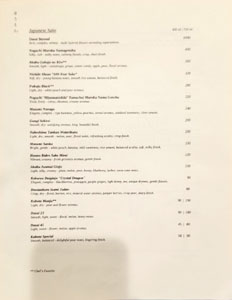
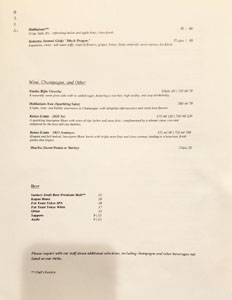
As for Sushi Yuen's menu, a $280 omakase is the sole option here. This stands in stark contrast to the à la carte offerings the restaurant had when it first opened. Pictured above is a selection of sake, wine, and beer, though do note that the Chef does occasionally offer "cult" sake (e.g. Aramasa, Jikon, Juyondai) when he's able to source it. Corkage was $75 a bottle, and no red wine is allowed due to concerns over staining of the unvarnished sushi bar. Click for larger versions.
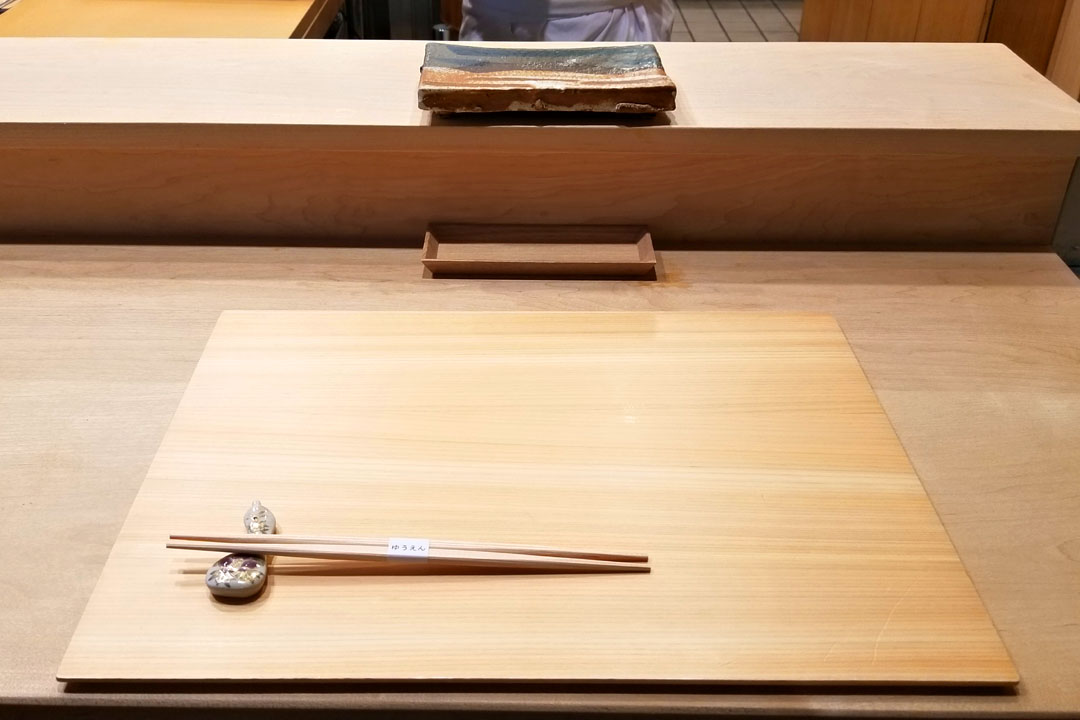
The place setting, complete with a minimalist wooden placemat.
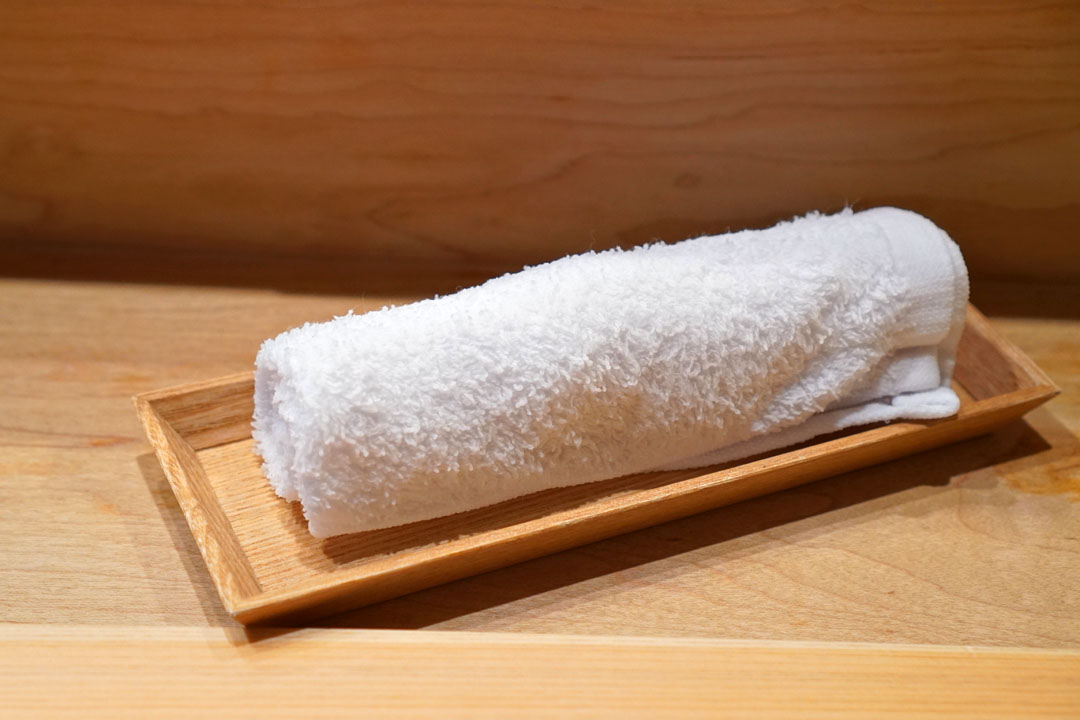
A chilled oshibori arrived soon enough.
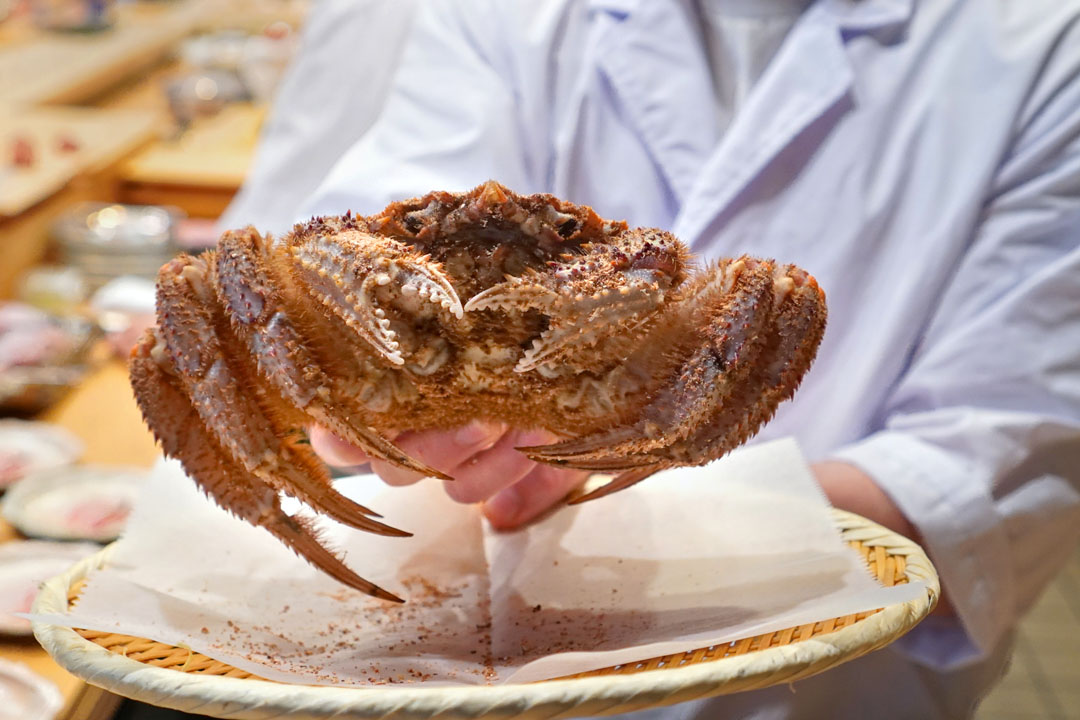
We were then greeted by the sight of a horsehair crab that would be featured later on in our meal.
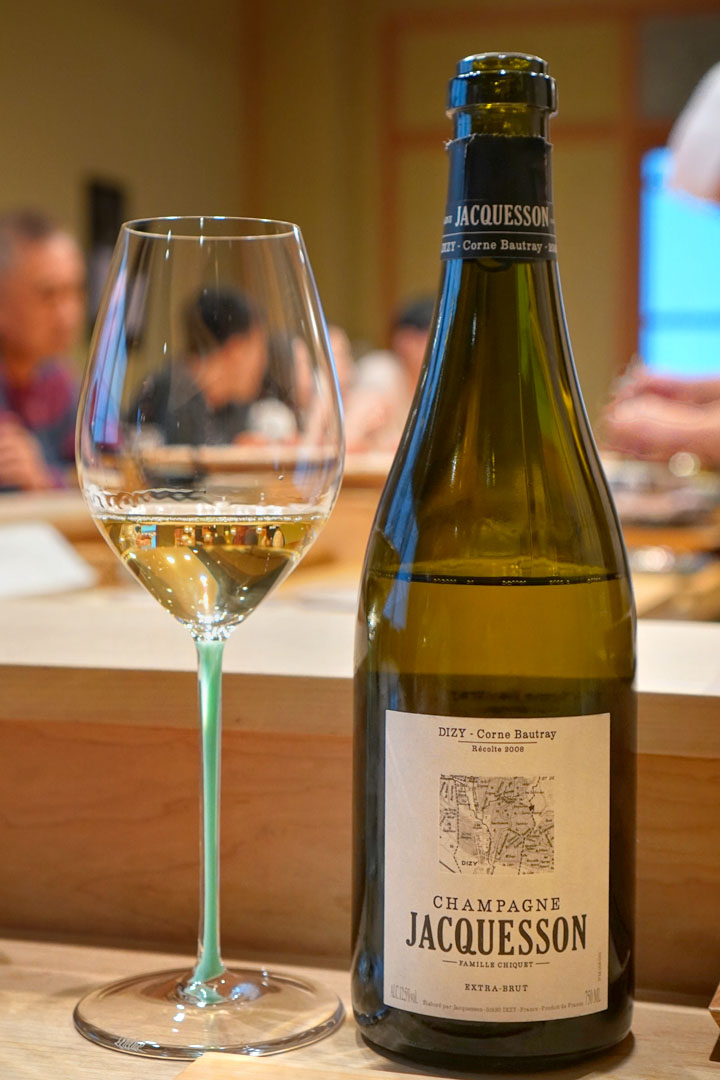
We BYOB'd tonight, and first to drink was the 2008 Jacquesson Champagne Dizy - Corne Bautray Extra-Brut, a non-dosé bottling disgorged in April 2018. The nose presented itself in a powerful, concentrated manner, with nutty, honeyed, oxidative, earthy nuances giving way to aromas of stone fruit preserves. On the palate, the wine was vibrant and lively, its almost jammy, apricot-like flavors and hints of apple juice juxtaposed against countering notes of oxidative, nutty astringency. With time, I began getting loads of yogurt in the mouth (think Yoplait), which transitioned to a healthy dosing of brioche as we finished the bottle, all while the bouquet went even heavier on the stone fruit. Overall, a commendable effort, one with plenty more to give in the coming years. In addition, I applaud the restaurant's use of Riedel Fatto a Mano glassware, as I liked how their colored stems made it easier to discern between our wines when there were multiple at play.
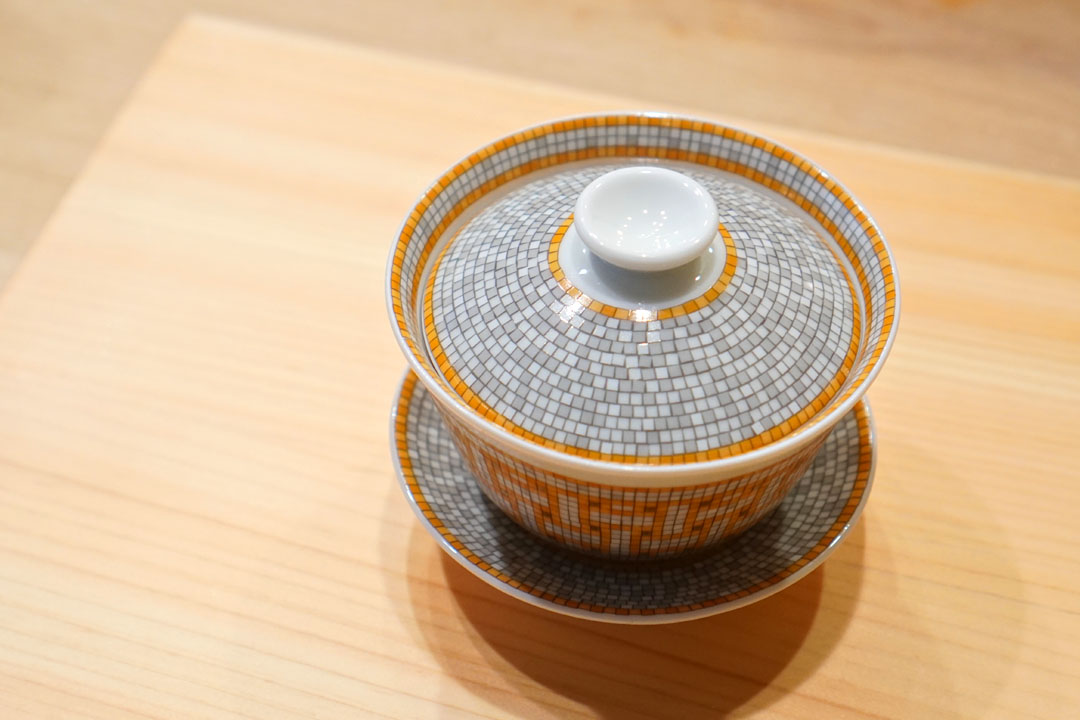
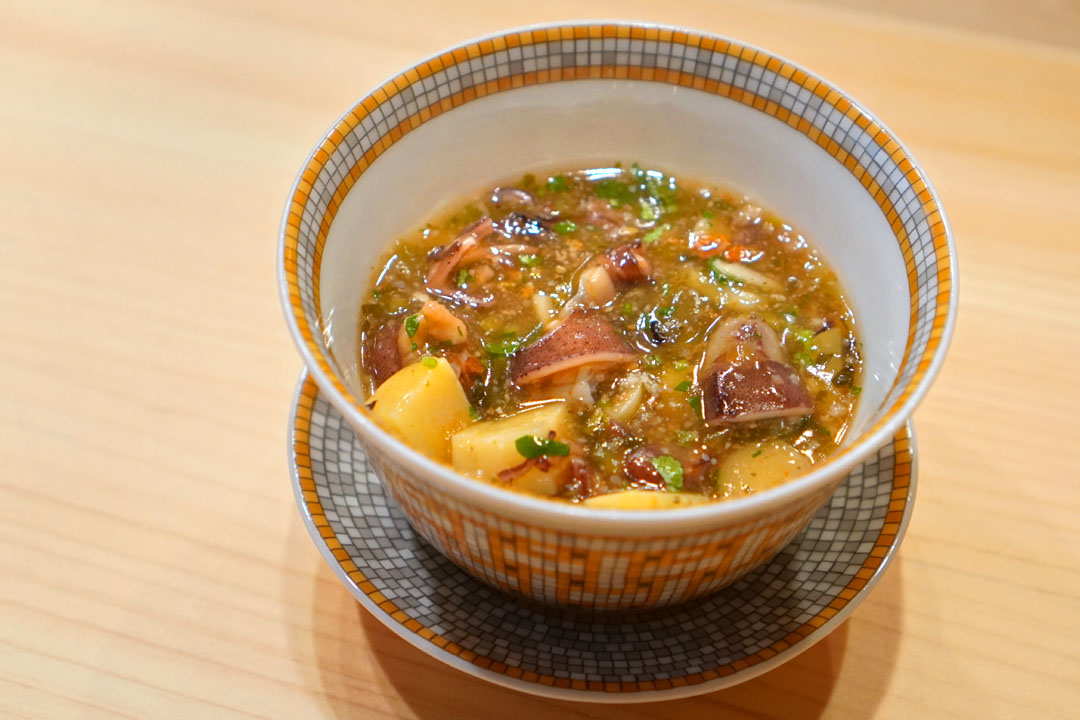
1: Chawanmushi
A meal at Sushi Yuen begins with a selection of kaiseki-ryori-inspired offerings. Our first course brought perhaps the heartiest chawanmushi I'd ever had. The star of the show here was hotaru-ika (firefly squid), which proffered a deep, earthy, subtly sweet salinity that meshed well with the savoriness of that jiggly egg custard. All that was smartly balanced by the brightness and crunch of both bamboo and, more intriguingly, white asparagus, which I'd never seen utilized in the dish before.
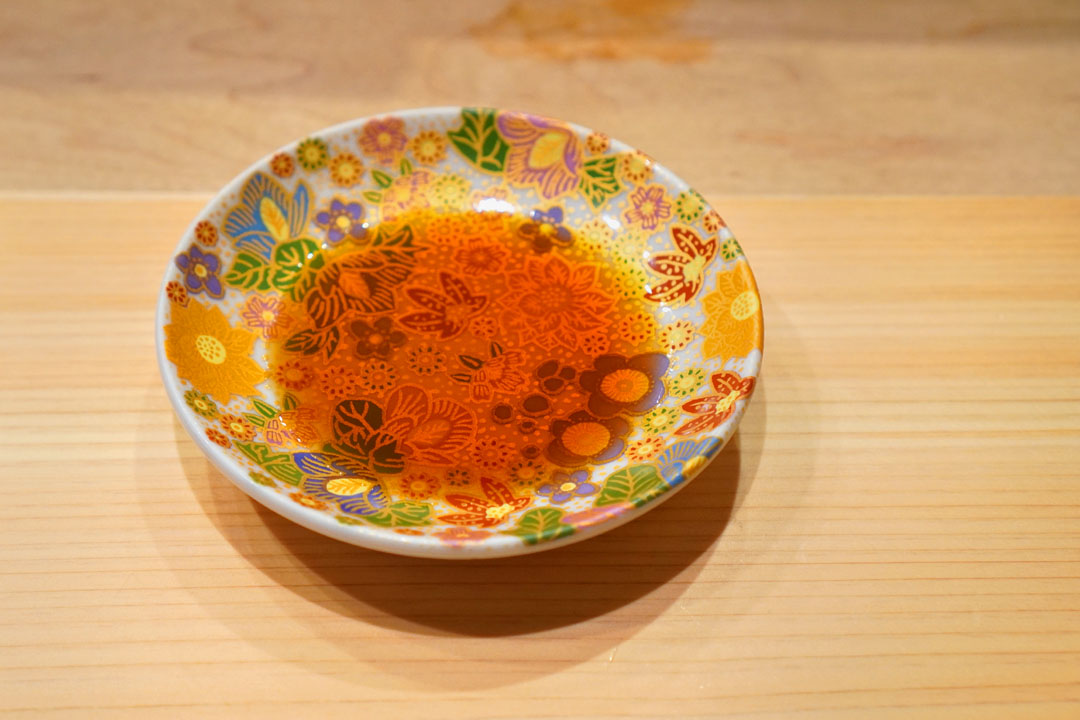
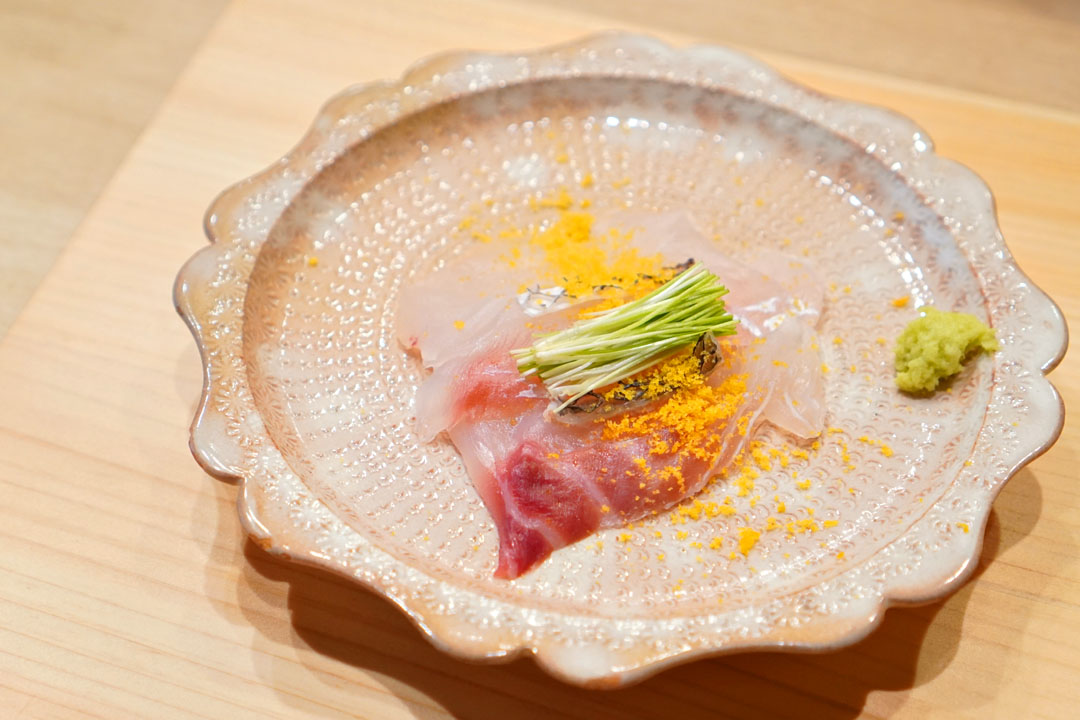
2: Madai Sashimi
We were at the peak of the season for red seabream, so it was nice to see it on the menu tonight. Sourced from Tokushima, the fish showed off a delicate sweetness that was well-complemented by the one-two-three punch of zesty negi, spicy wasabi, and salty shavings of three-month-dried karasumi, all while the piquancy of that soy sauce tied everything together.
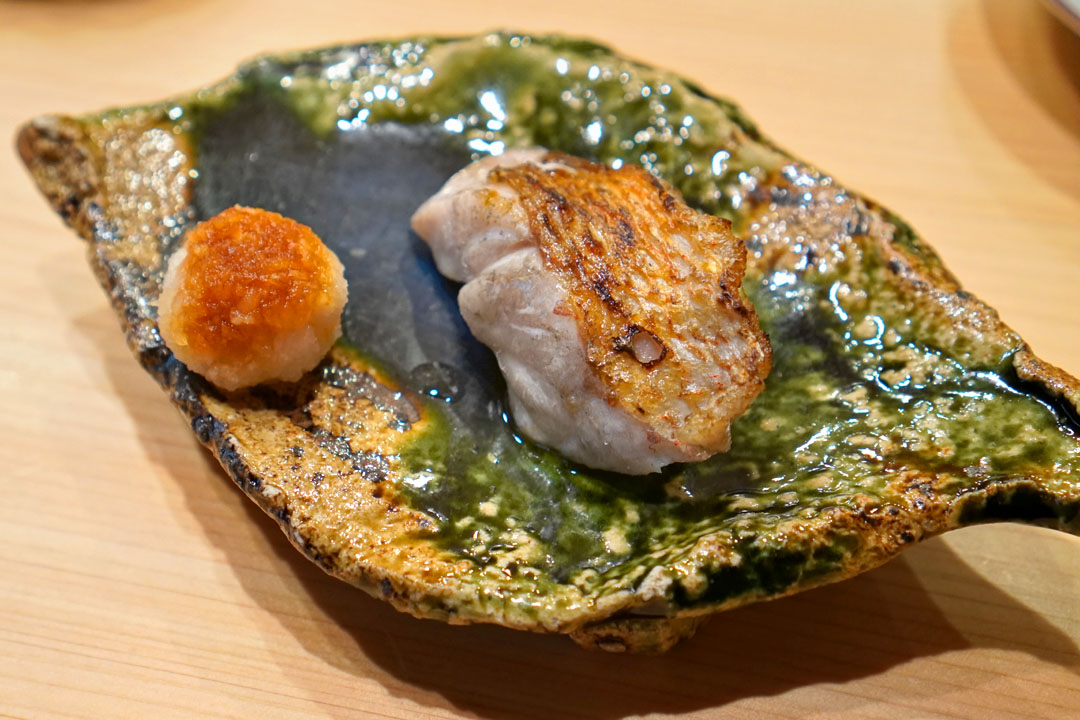
3: Yaki Nodoguro
Blackthroat seaperch is my favorite fish, so naturally I was happy to see it as part of the menu. Caught off the coast of Nagasaki, the akamutsu was grilled over Japanese charcoal, resulting in some wonderfully smoky skin encasing richly flavored, fatty, tender flesh. I appreciated the freshness from that mound of grated daikon on the side as well.
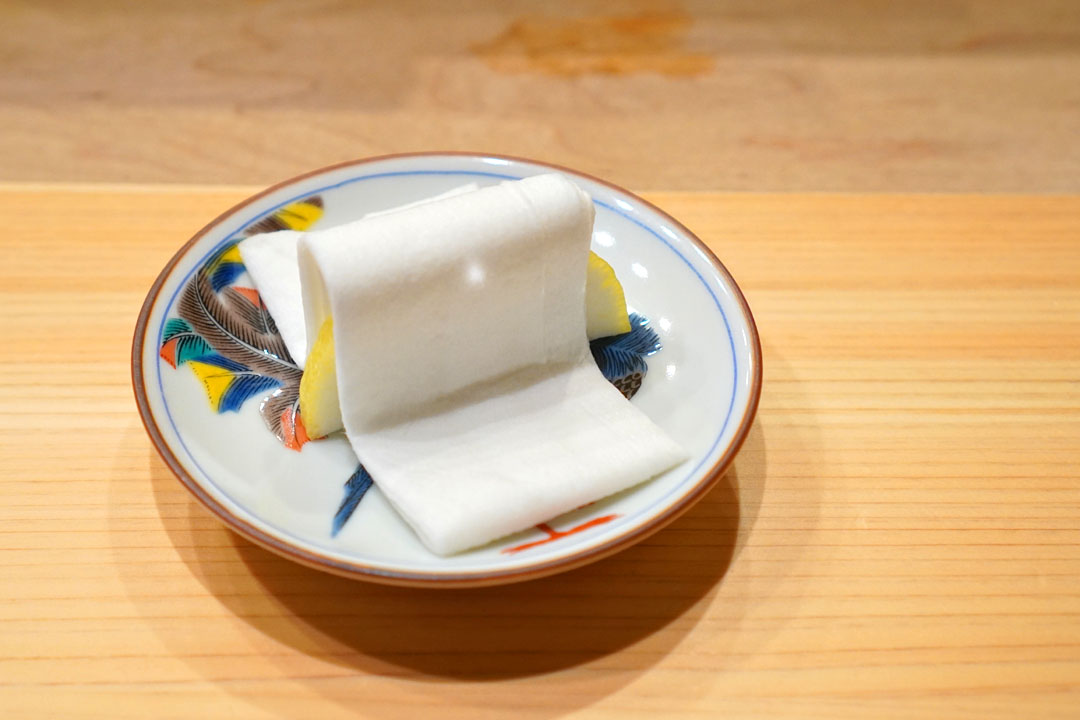
The arrival of a finger napkin signaled the start of the nigiri section of our dinner, and gave diners a gentle prod that the sushi should be eaten with our hands.
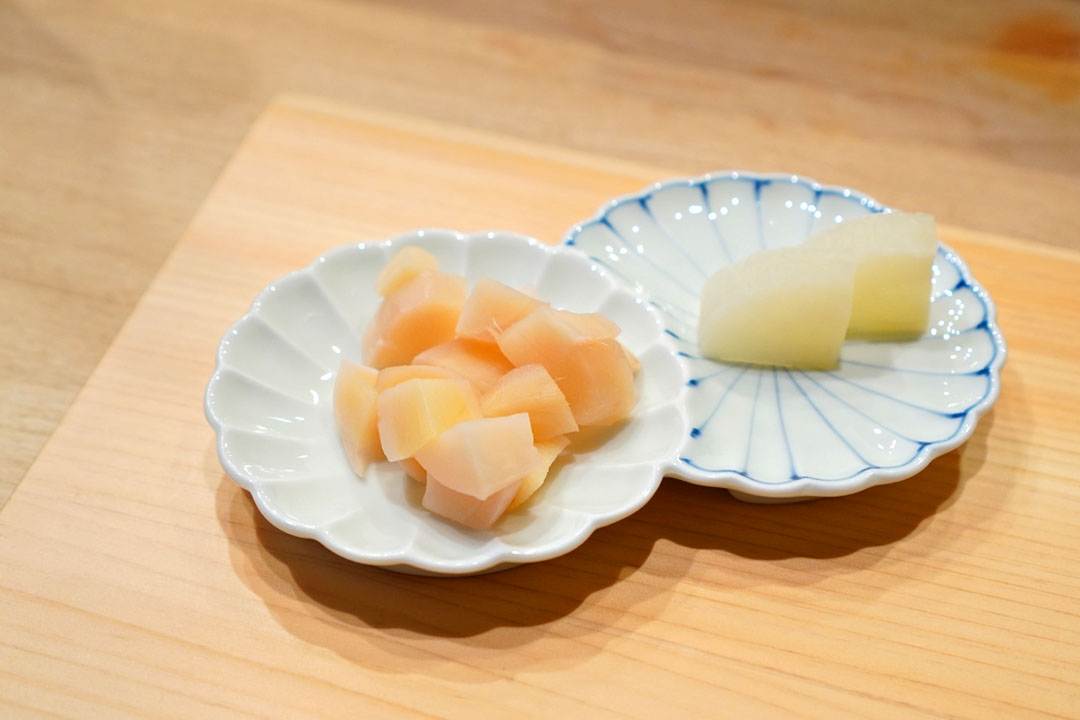
The gari was presented in cubed form, and offered a restrained, yet creeping spiciness along with the expected sweetness. More interesting was the pickled daikon, which was even sweeter, with a more apparent funk to boot. I was quite a fan of the radish's crunchy-yet-yielding texture as well, and would like to see it offered at more sushi-ya.
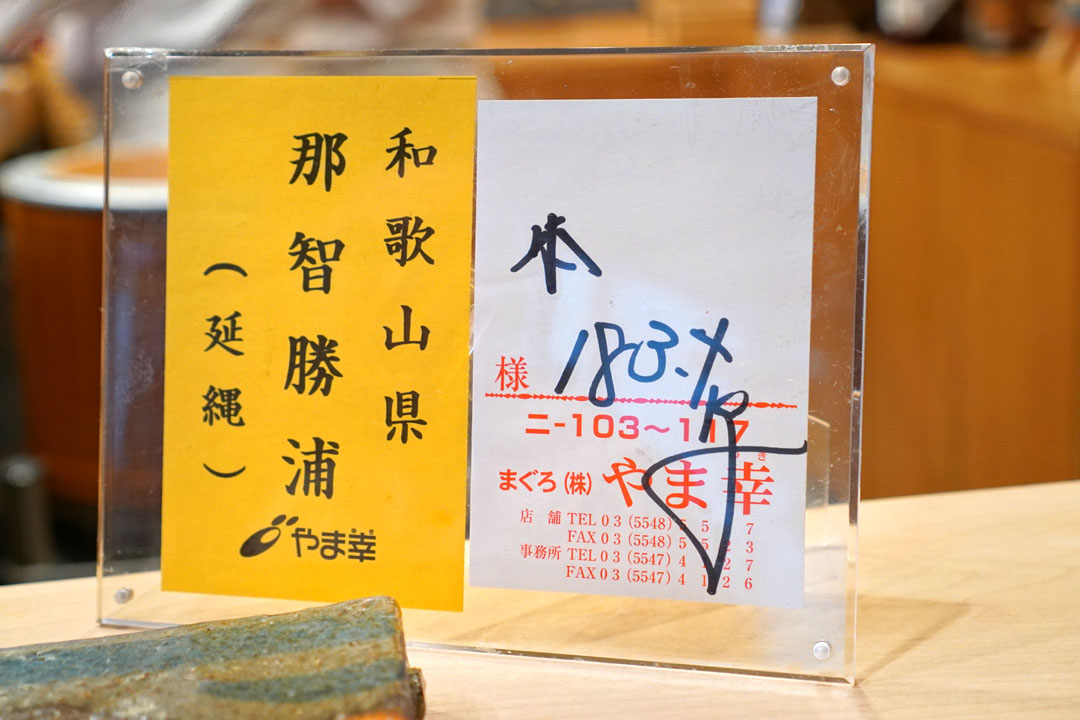
At this point, Ryan-san presented the certificate for his tuna, purchased from noted Toyosu Market supplier Yamayuki (やま幸). According to the provided documentation, tonight's bluefin was caught off the coast of Nachikatsuura (那智勝浦), Wakayama Prefecture (和歌山県) using the longline (延縄, or haenawa) method.
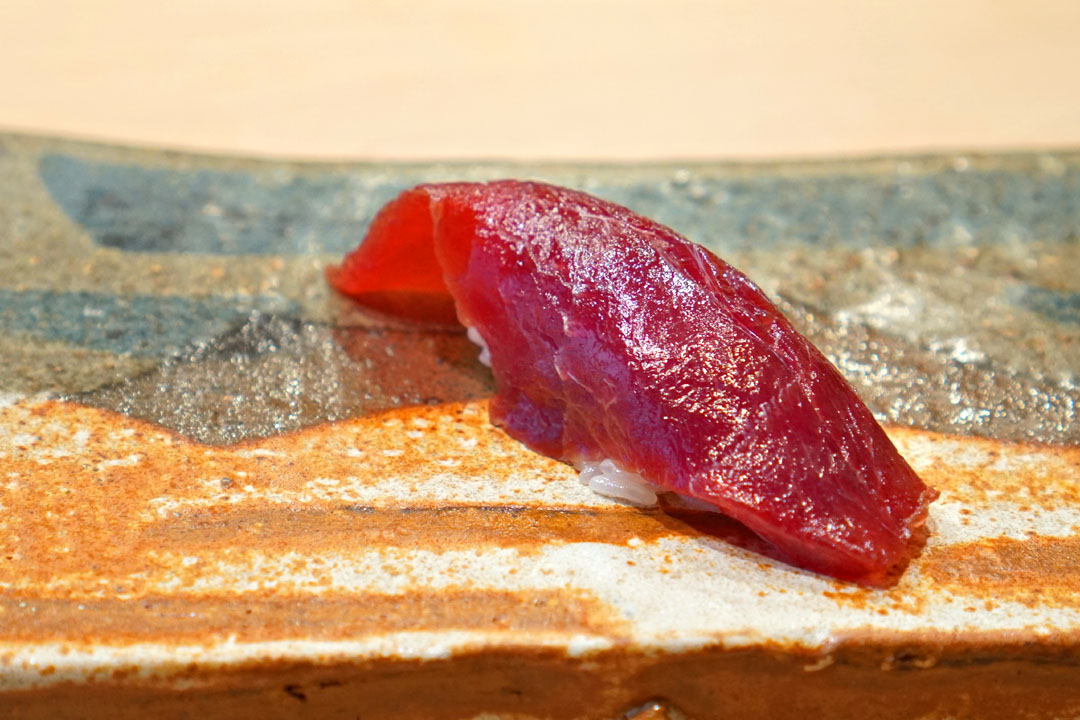
4: Akami Zuke
Up first was a garnet-hued cut of marinated lean tuna, one brimming with a potent brine and plenty of long-lingering, shoyu-boosted umami. Given the heady flavors going on, the counterpoint from the very neutral rice here was crucial.
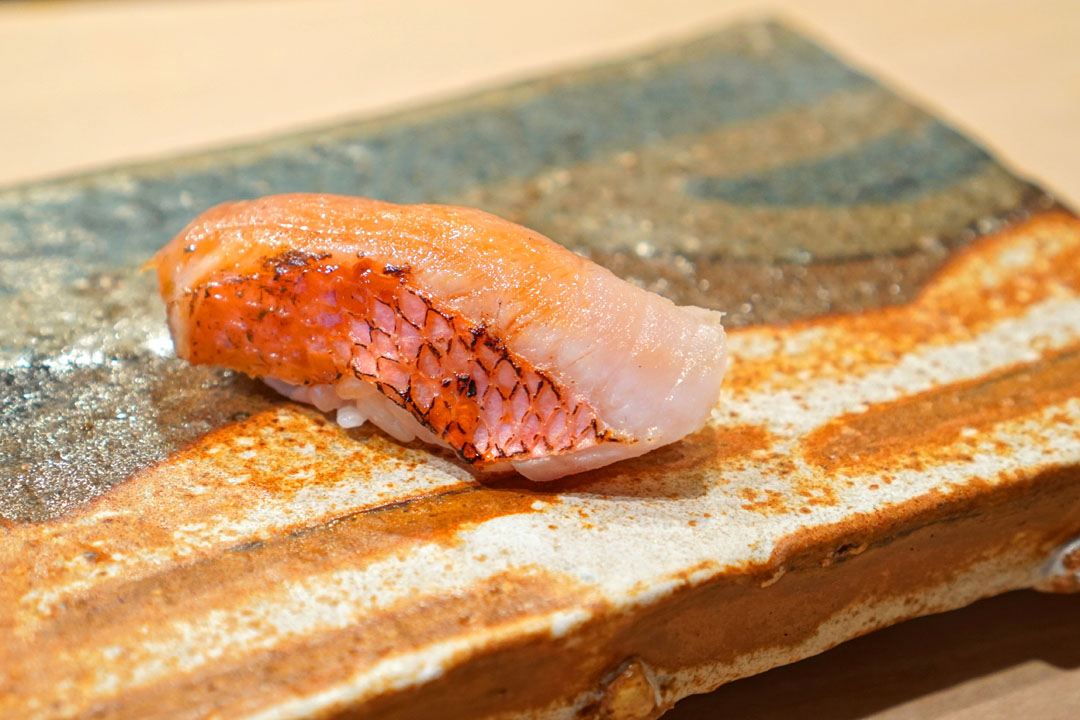
5: Kinmedai
Golden eye snapper is one of my favorite neta, and tonight's example from Chiba was done justice. There was a very discernable sweetness to the fish that juxtaposed beautifully with the smoke and sear happening, the shari doing a swell job mellowing everything out.
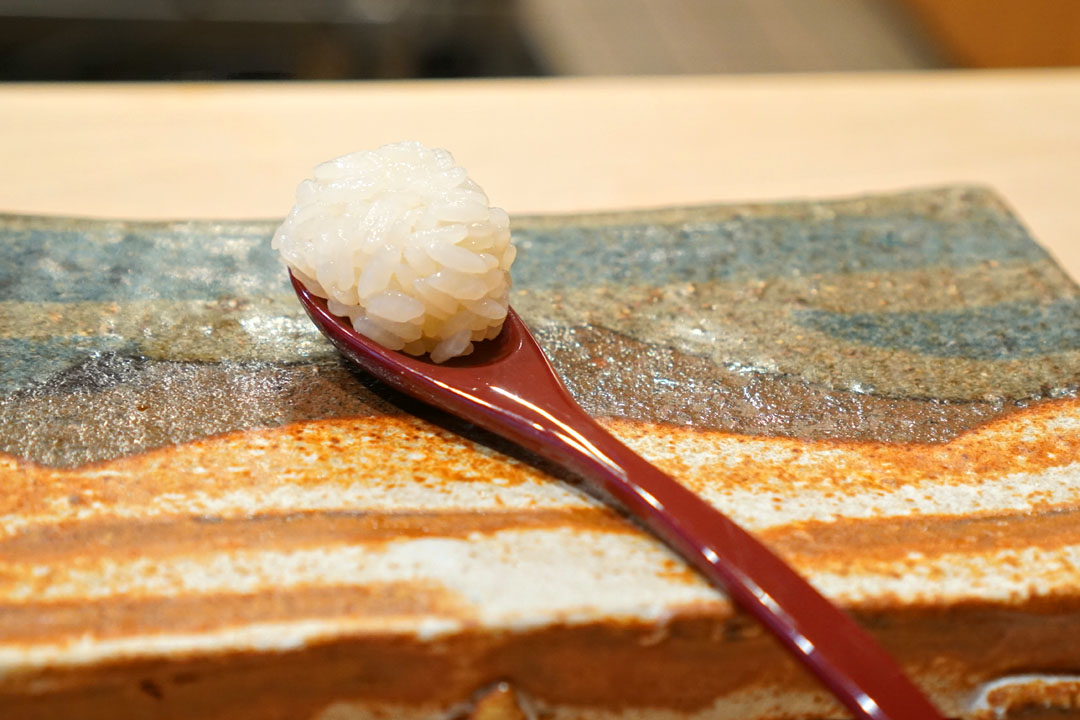
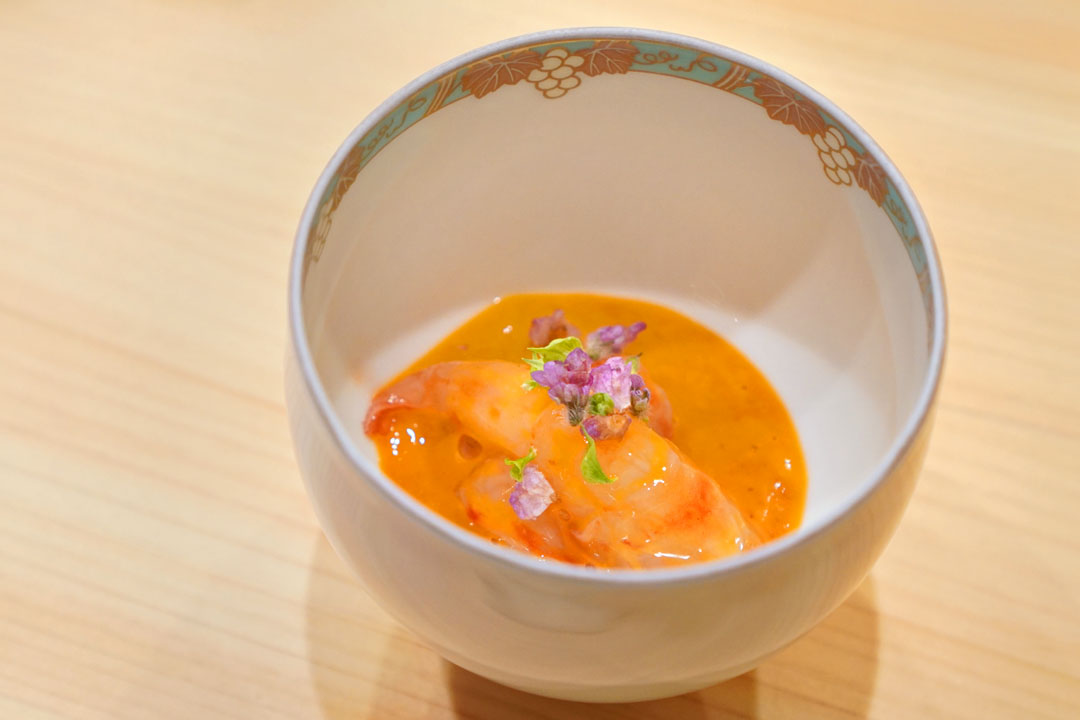
6: Botan Ebi
Botan shrimp ate sticky and sweet, and was set in an uni-based sauce that added another layer of "cooler" sweetness. I eagerly mopped up the remaining sauce with the provided rice, and liked the zing imparted by those shiso blossoms, too.
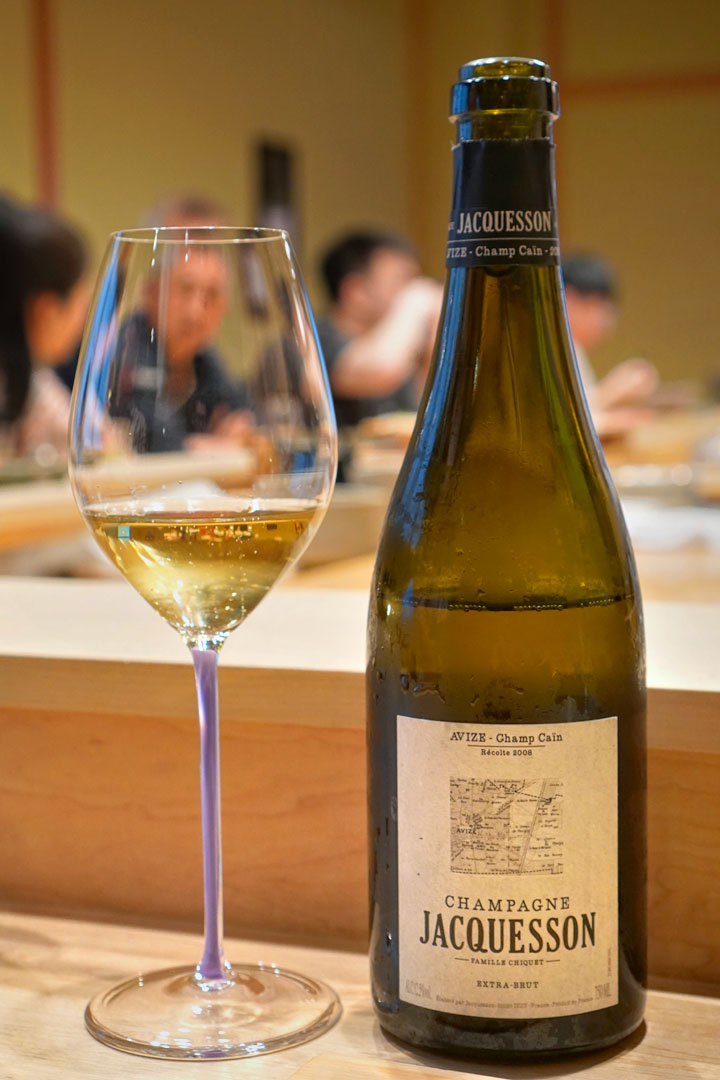
Our second tipple was the 2008 Jacquesson Champagne Grand Cru Avize - Champ Caïn Extra-Brut, which, like the preceding bottle, was disgorged in April 2018. The bouquet on this one went in some nutty, oxidative, honeyed, and earthy directions, while the palate was a bit more generous with the fruit compared to the first wine. As the sparkler evolved, I began getting loads more of that sweet, juicy apple on the nose, while taste-wise, things got even more luscious, but never overwhelmingly so due to a spine of offsetting astringency. It was certainly fun to have these two Jacquesson expressions back-to-back.
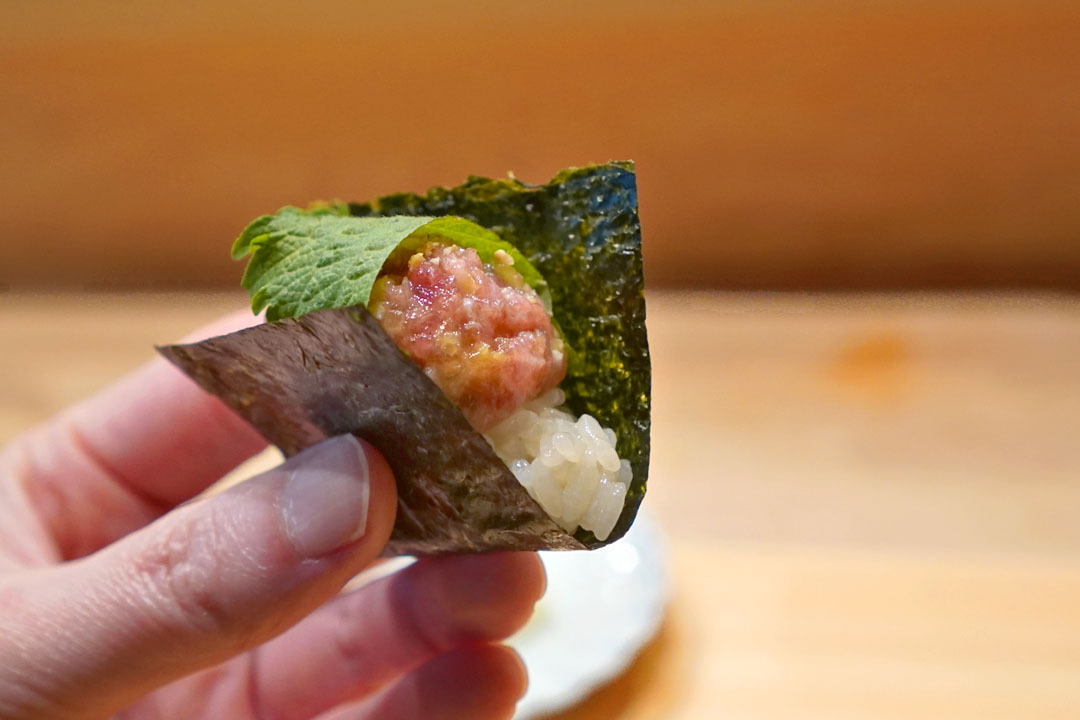
7: Toro-Taku
What we have here is perhaps the best version of toro-taku I've eaten. The pairing of that lush, fatty tuna with crunchy, pickle-y bits of takuan was a match made in heaven, and I also loved the sheer herbaceousness of the bite. Also critical was the moderating effect of the rice, as well as the hit of oceany umami from the nori on the finish.
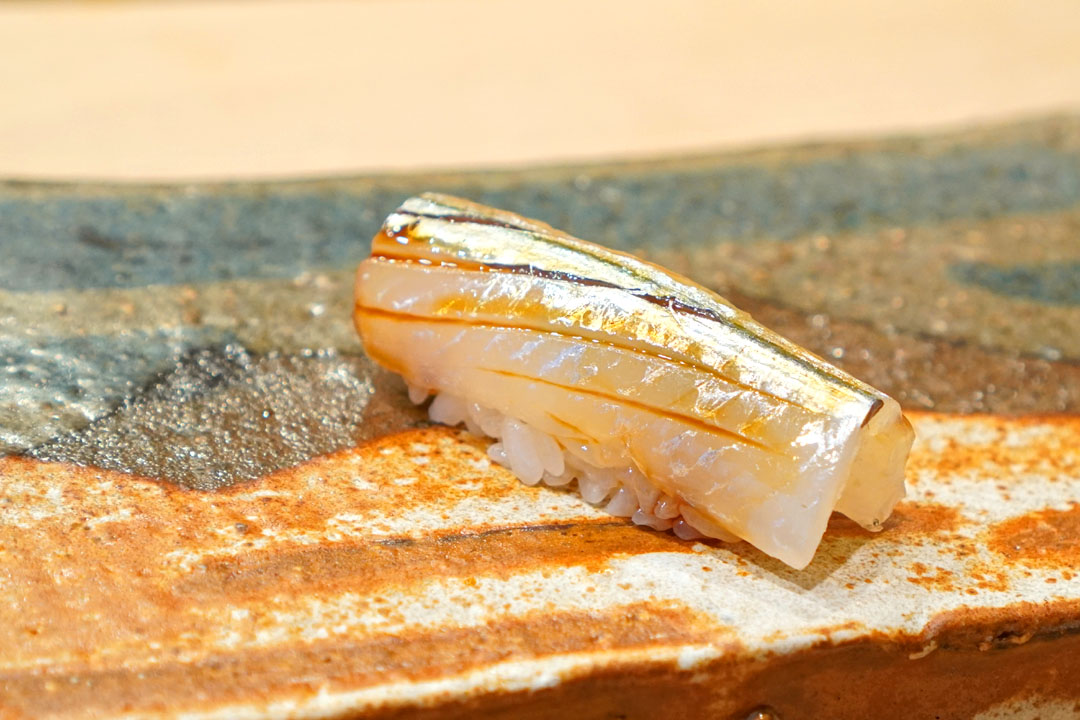
8: Sayori
Needlefish showcased a slick, firm-ish consistency along with a marked sweetness that paired easily with the growing heat of wasabi. At the same time, the rice certainly worked for contrast, and was seemingly more assertive both in terms of taste and texture.
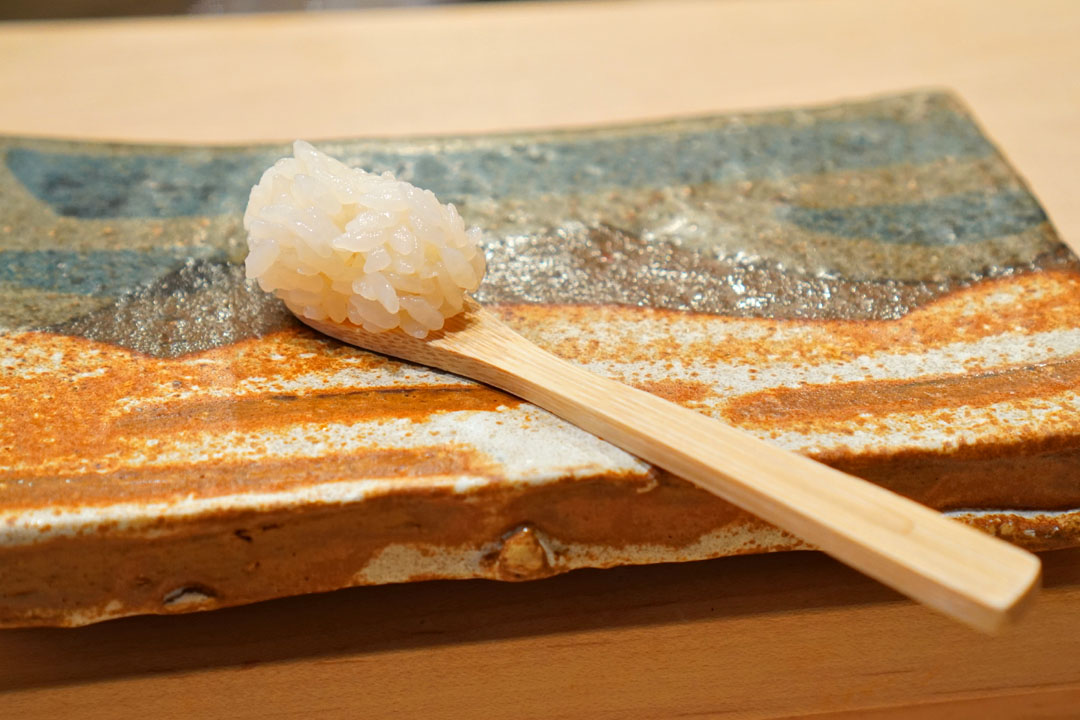
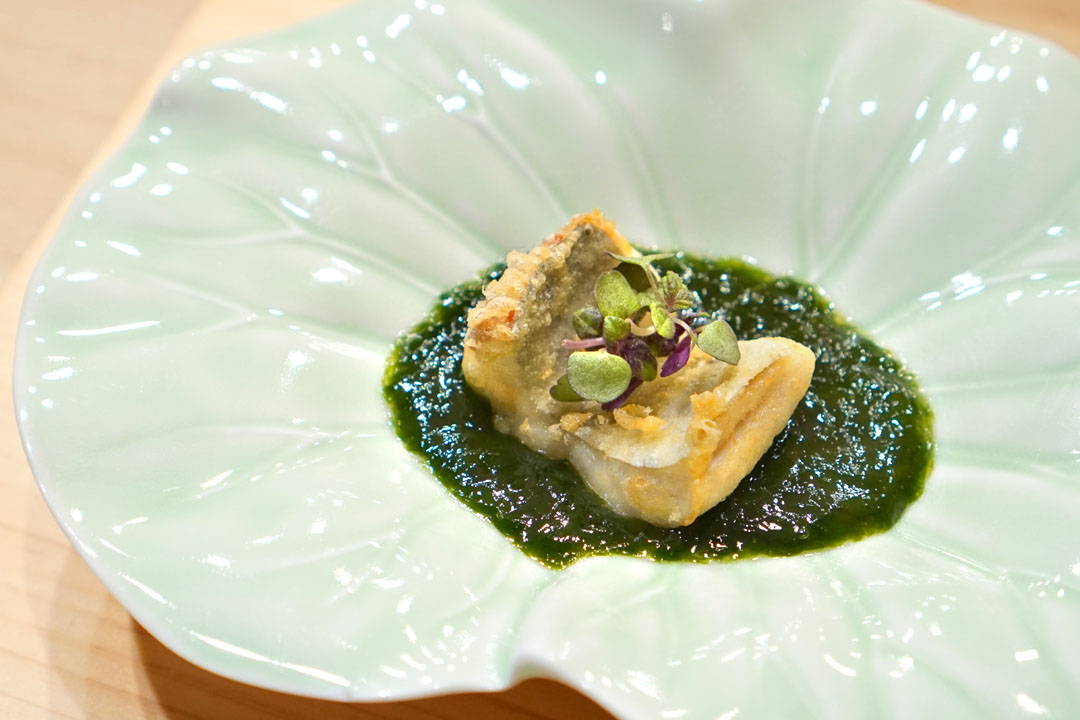
9: Age Tachiuo
Beltfish displayed a lightly-fried exterior along with some full-flavored, elegantly briny flesh. The fish was tasty alone, but was taken up a notch by a topping of micro red shiso and a sauce teeming with the vibrant, grassy nature of aonori seaweed. And once again, some additional rice was provided to help us mop up.
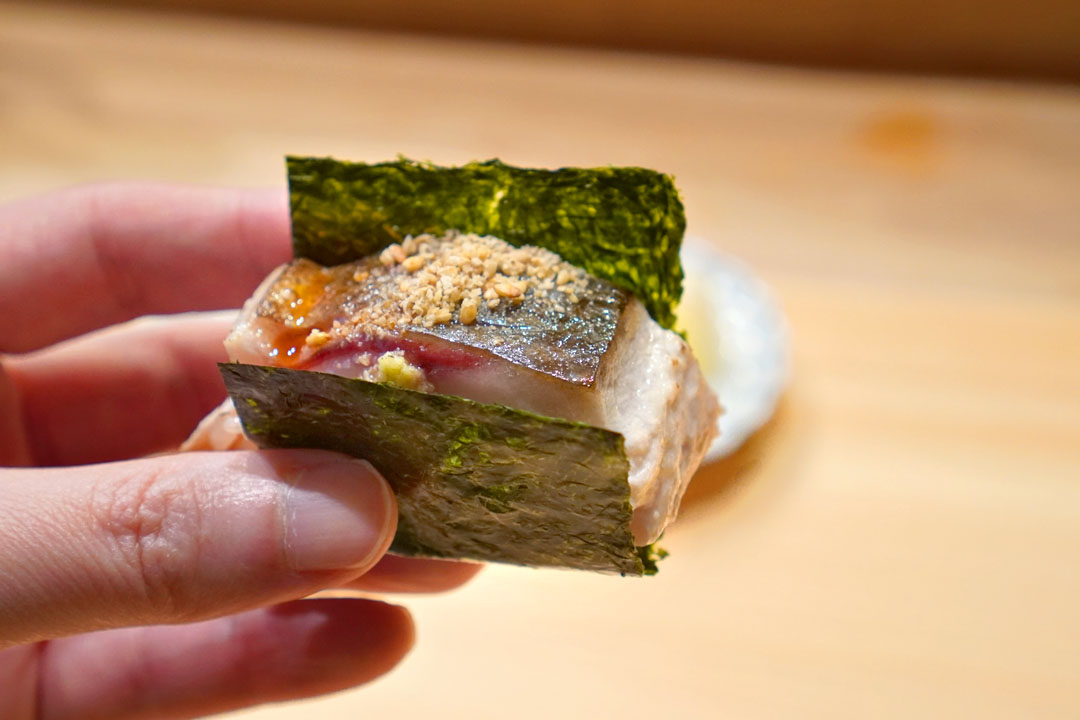
10: Saba Bozushi
The mackerel was a favorite. The fish's aggressive, yet somehow elegant salinity was proudly conveyed, beautifully complemented by hits of smoke and the lingering heat of wasabi, all while the seaweed and su-meshi served as the consummate mitigating elements.
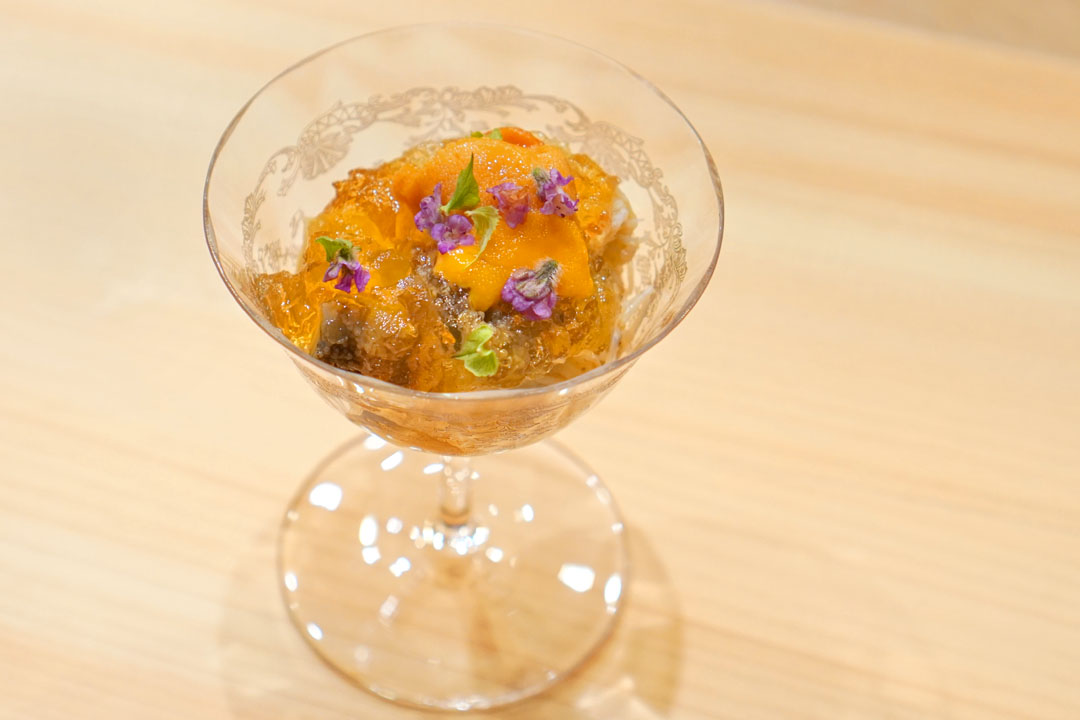
11: Kegani
The hairy crab from the start of dinner finally made its long-awaited return, its almost "fluffy" flesh demonstrating plenty of sweetness to go along with the tang of tosazu jelly. At the same time, the hanaho added a zippiness to the equation, and I very much liked the additional depth and textural variation provided by the black abalone. Curiously, this actually reminded me of a somewhat similar crab dish I had a few years ago at Nihonryori Ryugin in Tokyo.
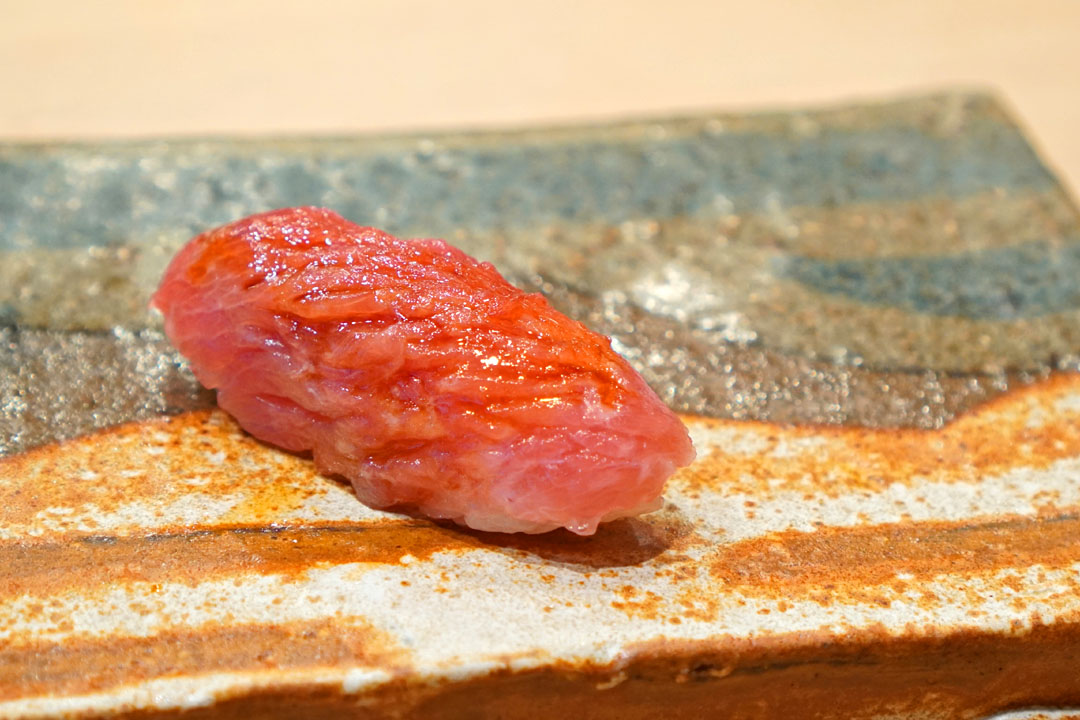
12: Sujinuki Otoro
Next came an uncommon sight around these parts: toro with the tendon removed, referred to as suji nuki (すじぬき). The result of this extra effort was a noticeably more silken mouthfeel in place of a more overt fattiness. In terms of taste, the tuna possessed boatloads of umami along with a real sweetness, so given the robust flavors at play, the warmer, more acidic rice was key for balance.
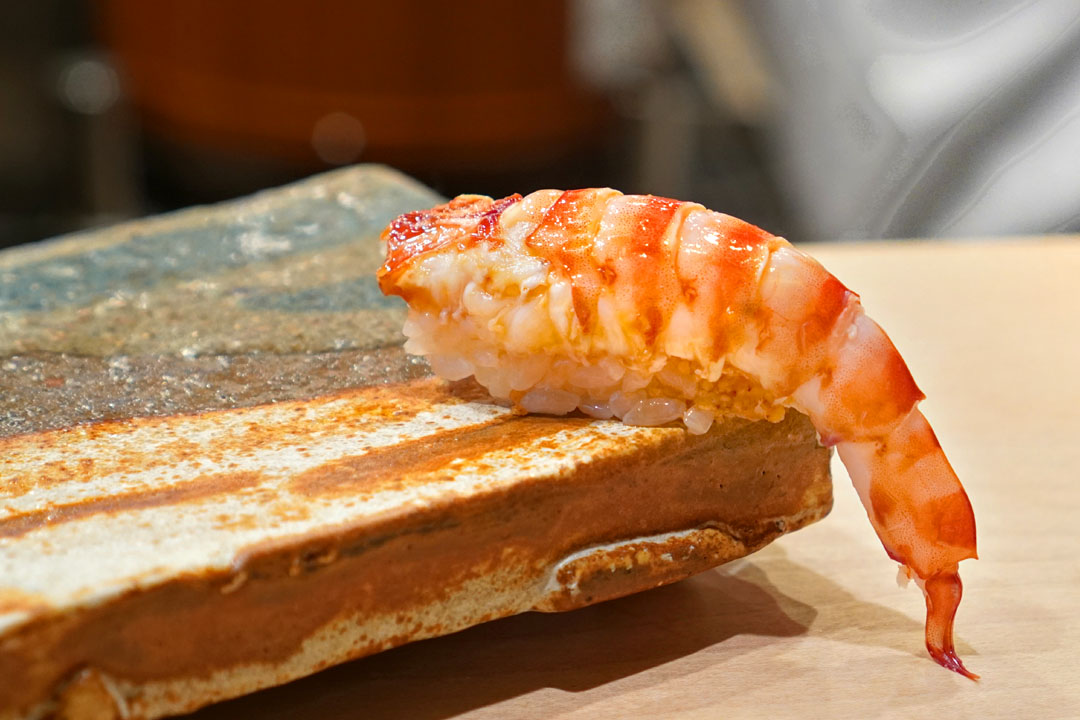
13: Kuruma Ebi
Japanese tiger prawn was a treat, and what struck me first was its simultaneously soft, spongey, and satisfying texture. The kuruma shrimp wasn't shy at all about its considerable sweetness either, so the tempering effect of the rice--whose texture was emphasized here--really made a whole bunch of sense.
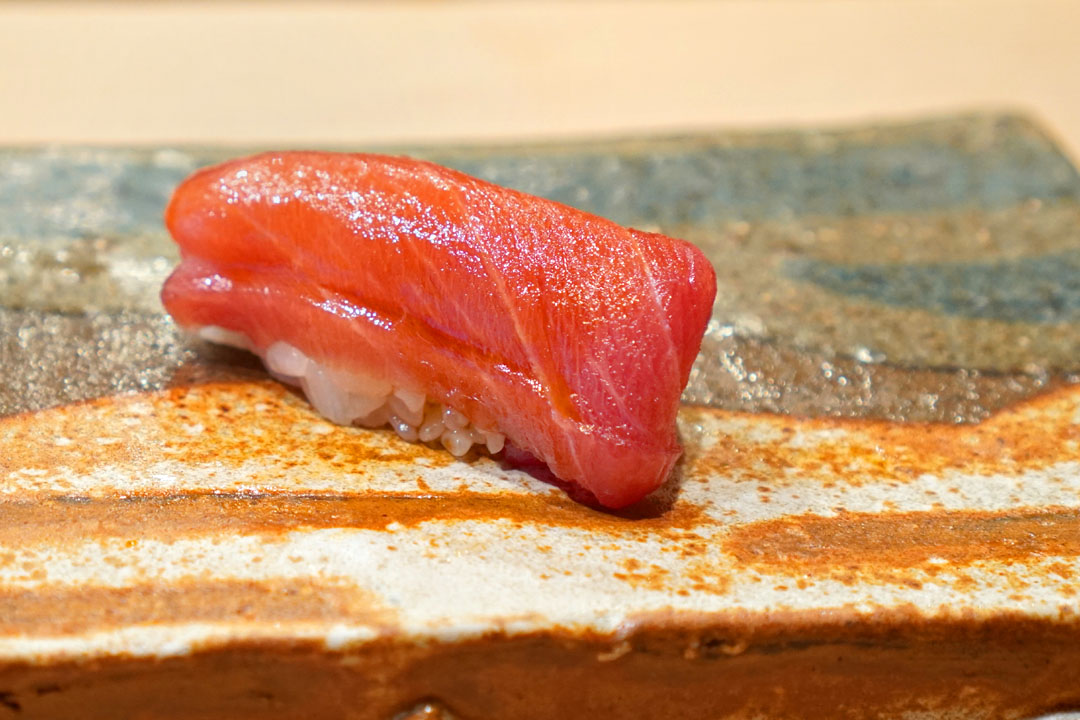
14: Chutoro
Medium fatty tuna was quite a different experience compared to the toro above. The most obvious distinction was the more vigorous mouthfeel to the fish, while its lower levels of umami highlighted the cut's sweetness, especially when contrasted against the somewhat vinegar-forward rice.
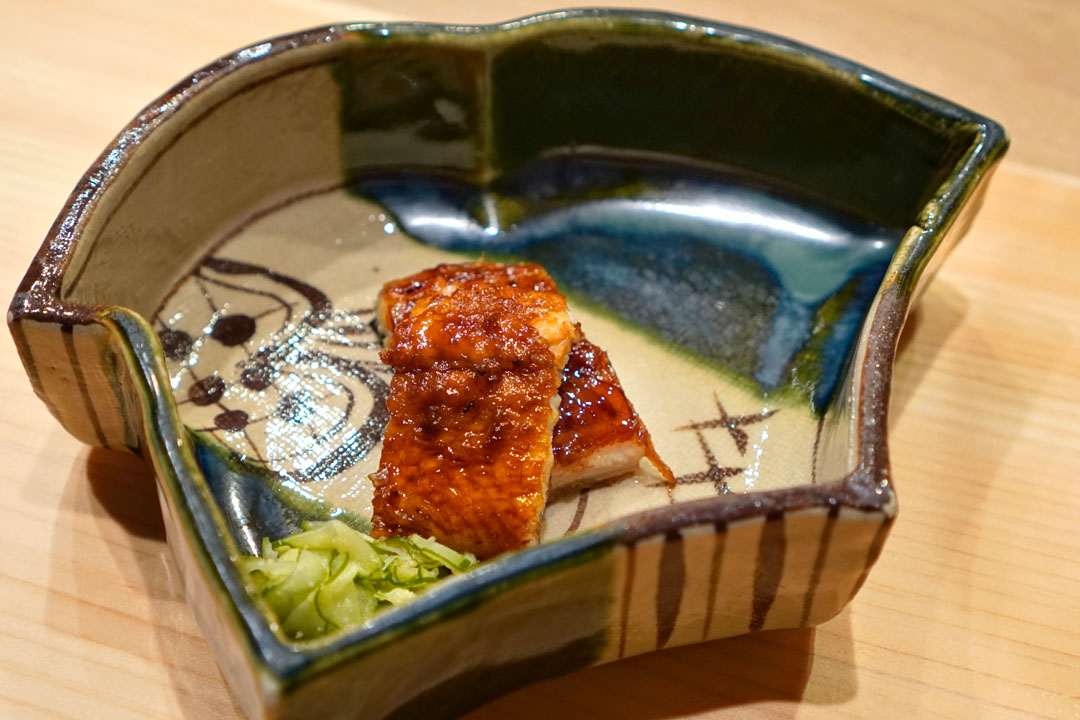
15: Unagi
An unakyu-style presentation of freshwater eel was up next. The fish's textbook marriage of sweetness and smoke was just as you'd expect, and well-matched with the brightness of cucumber.
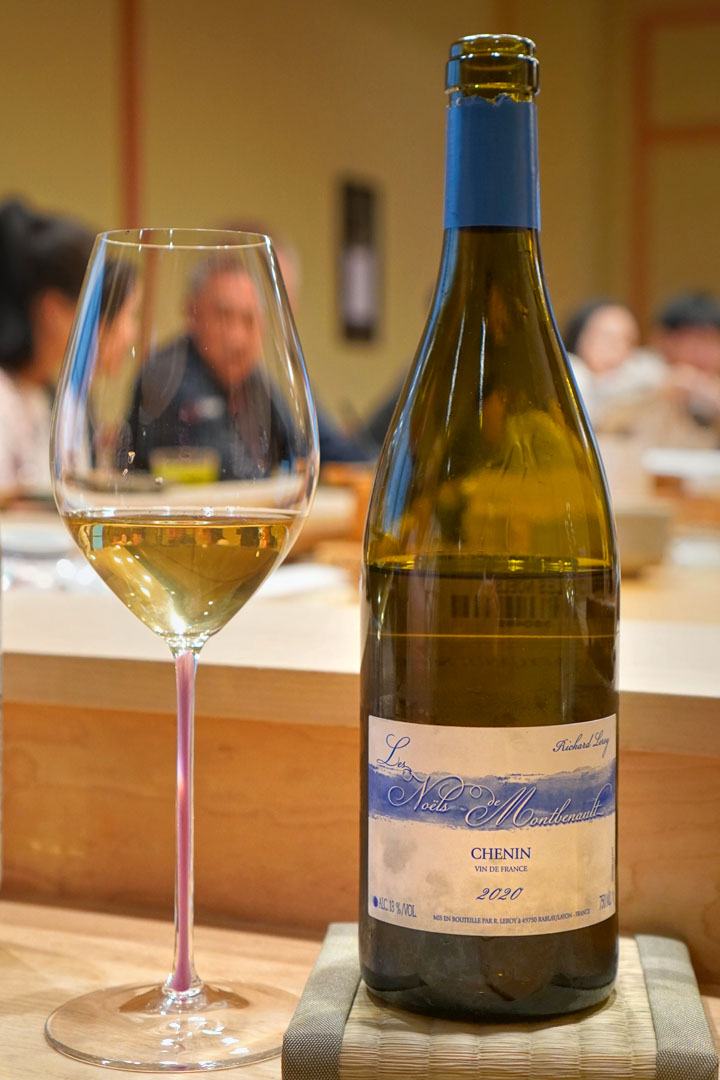
Our final bottle was something more unexpected, the 2020 Richard Leroy Les Noëls de Montbenault Chenin. On the nose, the wine was unabashedly dry, its aromas of green apple commingled with a distinct earthiness and a touch of minerality. Taking a sip, I found this almost bracing dry and crisp, with more of those orchard fruit notes playing with nutty nuances, traces of saline, hints of citrus, and a bit of a reductive quality. It was actually beer-like at times, which I didn't mind at all, and given that I don't drink much Chenin blanc, it was a joy to sample this tonight.
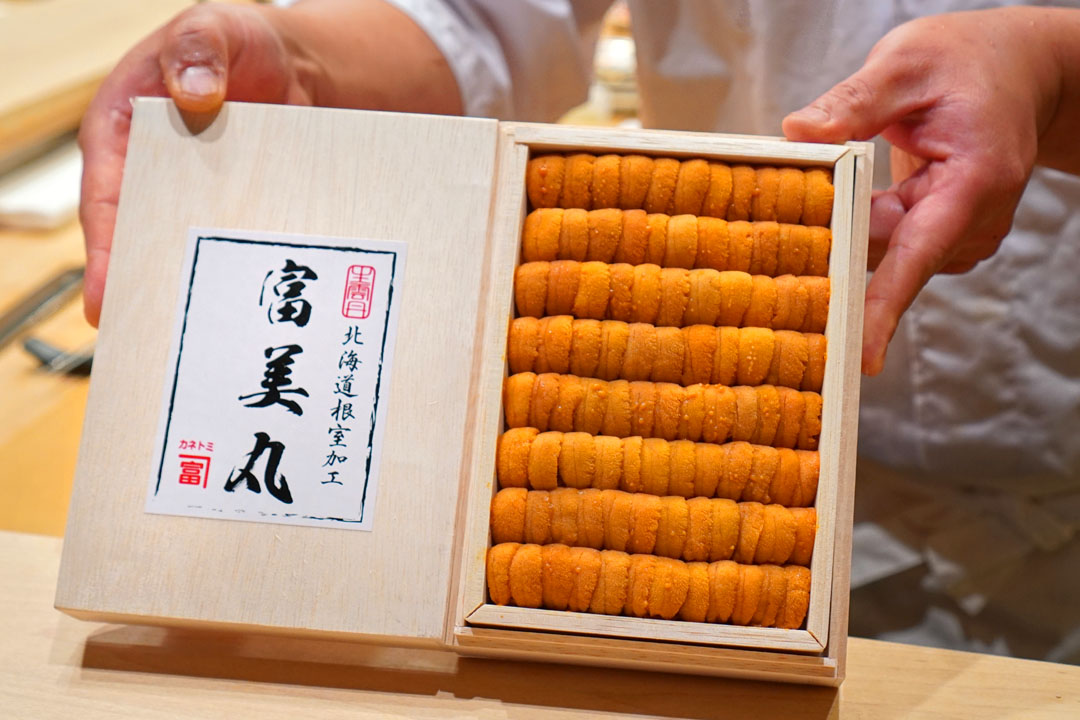
Chef Ryan then brought out a rather comely tray of uni from the brand Kanetomi Fumimaru (カネトミ富美丸水産) out of Nemuro, Hokkaido (北海道根室).
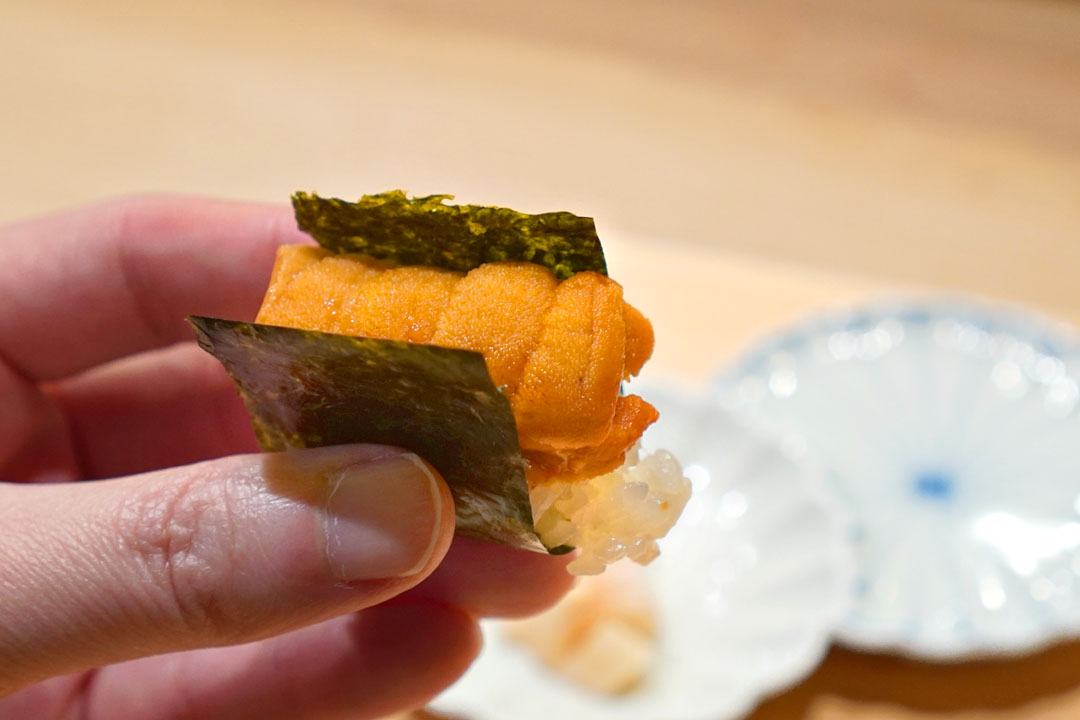
16: Bafun Uni – Kanetomi
The sea urchin from the box above was pretty much exactly what you'd want, its spot-on meshing of sweetness and salinity delivering in classic fashion, perfectly augmented by lightly seasoned rice and crispy seaweed.
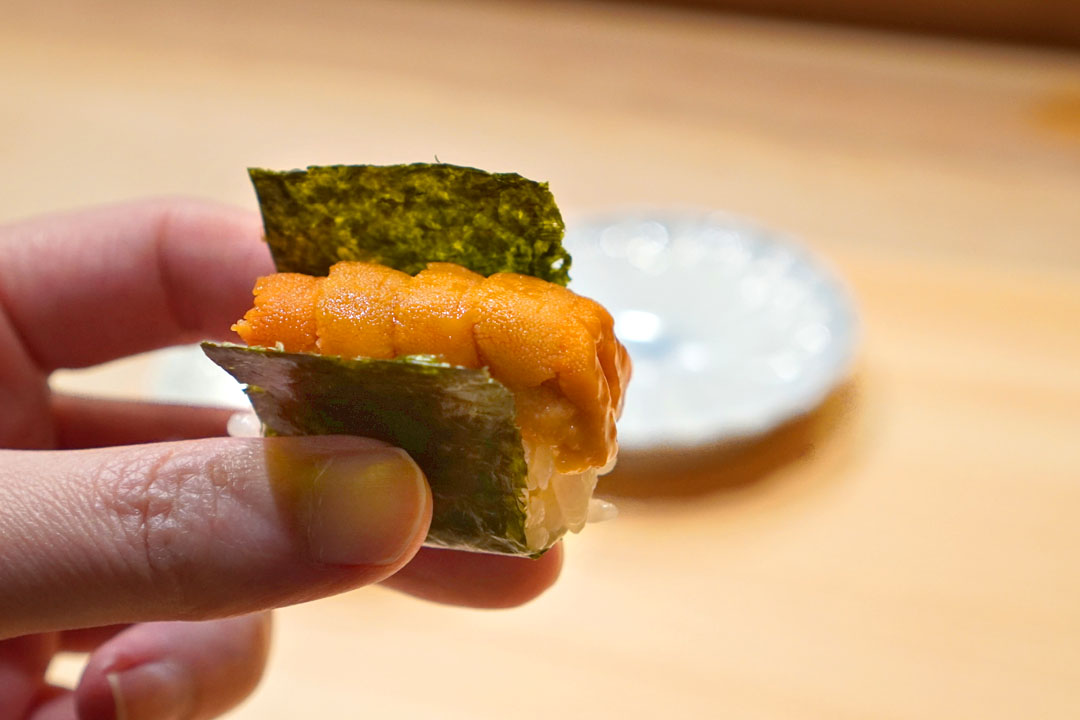
17: Bafun Uni – Kaneyo
Kwak-san mentioned that he'd ordered 10 trays of Kanetomi, but only received five, so he made up the difference by sourcing the remaining boxes from Kaneyo (カネヨ鴎洋水産), another Nemuro-based supplier. There was actually quite a noticeable difference between the two. In essence, what we had here was less overtly creamy and sweet, and instead exhibited a "cooler," more mineral-driven character that melded particularly well with the nori.
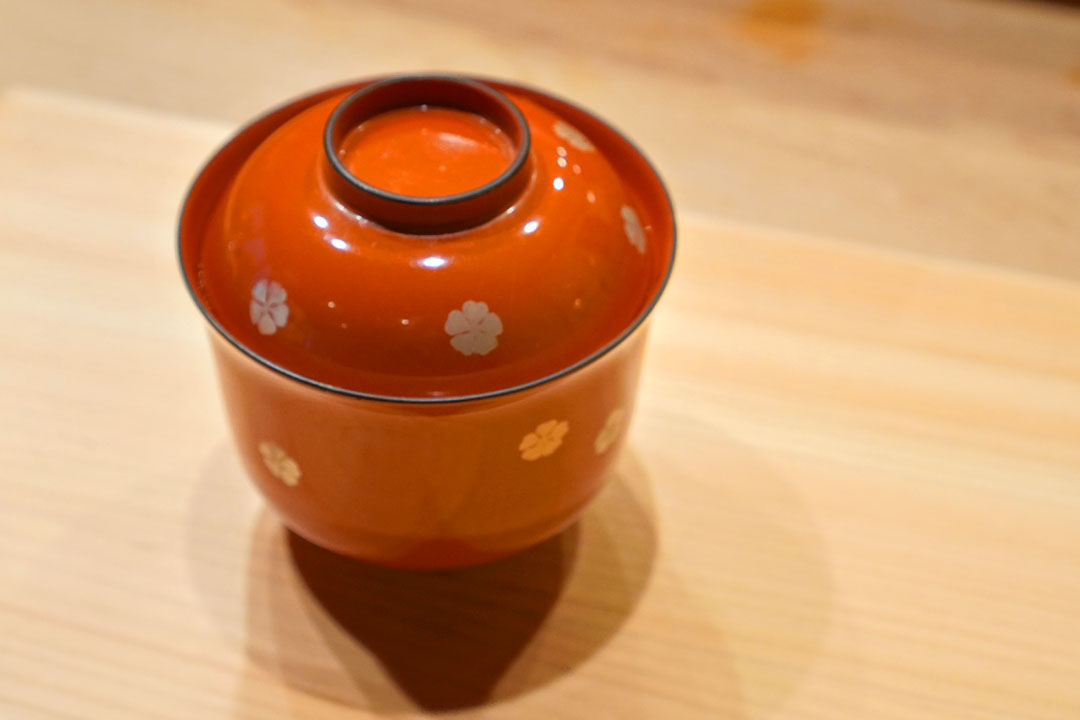
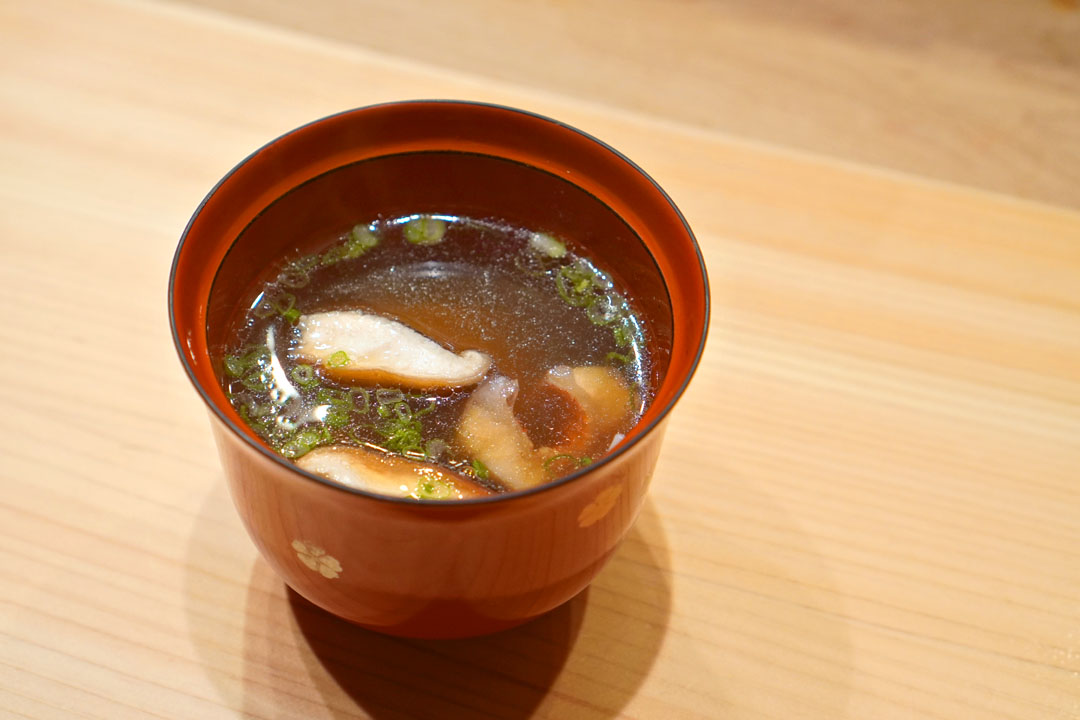
18: Inaniwa Udon
A cozy cup of udon soup really hit the spot. I was a huge fan of the noodles' slick, supple, yet ever-so-slightly-chewy texture, while the broth delivered in spades with its robust flavors of mushroom and kinki.
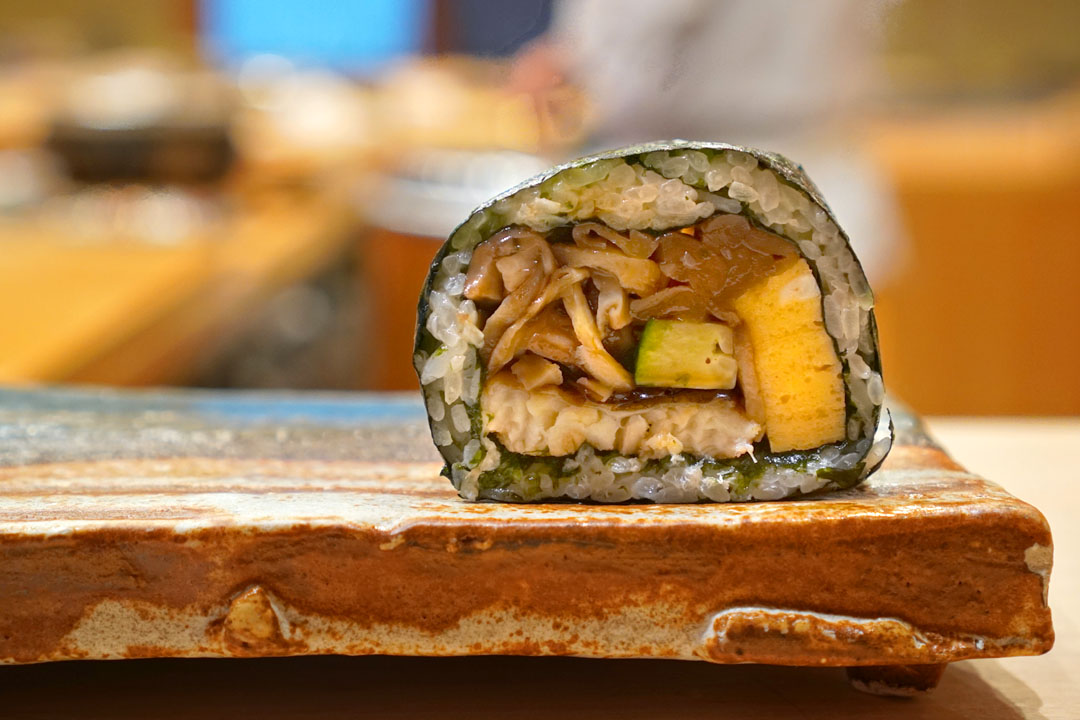
19: Futomaki
Here we see what must be one of the larger sushi rolls I've had, filled with housemade tamago, Japanese cucumber, dried gourd, shiitake, and anago. It served as a fitting closer thanks to its multitude of disparate tastes and textures, all bound together by just enough seaweed and rice. I was especially fond of the sweet-tanginess from the kanpyo and how that augmented the roll's savory, woodsy flavors.
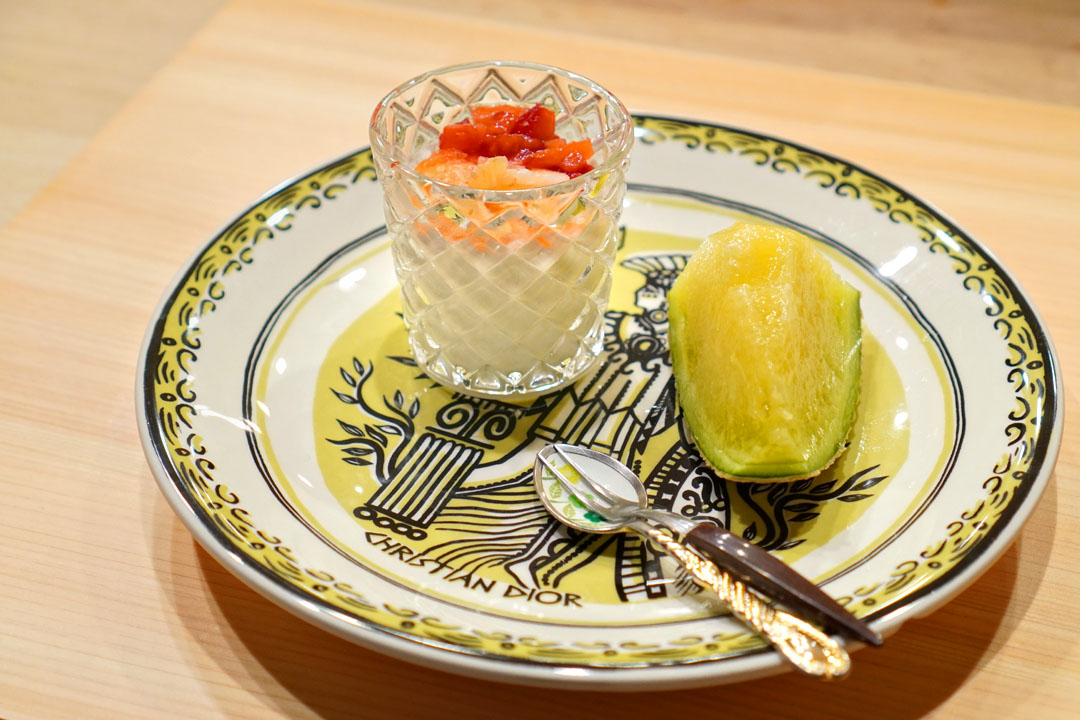
20: Mizumono
Dessert duties were handled by a creamy, berry-enhanced panna cotta and a slice of ultra-sweet, ultra-juicy Japanese muskmelon (all served on a Christian Dior plate, no less).
Wow, what a difference a couple of years have made. Following my first meal at Sushi Yuen, I found the food solid though unremarkable, but now, what the team is putting out is worth boasting about, comparing favorably to what I've experienced at some of the top sushi spots in Los Angeles. Chef Kwak's cooking is hard to fault, and what I also appreciated was his ethos--humble, ebullient, always learning, always striving. I have to imagine that this is the best place for sushi in the eastern stretches of the San Gabriel Valley, and even if we consider the SGV as a whole, my thought is that only Kogane can compete.
18558 Gale Ave, City of Industry, CA 91748
626-295-2283
www.sushiyuen.com
Sat 04/12/2025, 05:00p-07:20p

My first exposure to Sushi Yuen (寿司 ゆうえん or 寿司 遊園) was in May 2020, the early days of the pandemic, when I ordered some takeout. I ate said takeout in the backseat of my car and didn't think too much about the place after that. However, things changed when I found out that the restaurant had shifted concepts, and was now a much higher-end, omakase-only, edomae-style affair helmed by Chef/Owner Ryan Kwak (a.k.a. Seeun Kwak). The switcheroo immediately piqued my interest, and I soon put Yuen back in my spreadsheet of spots to check out.
About the Chef: Kwak Se-eun (곽세은) was born in South Korea in August 1988 to a family in the food service business. Both his father and grandfather were chefs focused on Japanese cuisine, and operated an eatery specializing in pufferfish (fugu). Dad passed away relatively early, and given that Kwak was still a minor at this point, he was unfortunately unable to take over the restaurant, which was subsequently sold. When the Chef was 15, his family immigrated to the US, and at age 17, he decided that he wanted to pursue a career in sushi.
He thus began his education in 2006, working locally in Little Tokyo and Marina del Rey while also being sent by his teacher (a former judoka) to train in Yamanashi, Japan. After slowly but surely improving his skills, he teamed up with his brother Jaeeun Kwak (곽재은 or Kwak Jae-eun, b. February 1992) and debuted Sushi Yuen in October 2019. However, the younger Kwak ended up moving to Texas with his wife's family in 2021, and now runs Sushi Yume in Round Rock. Following the departure, in April that year, the decision was made to transform Sushi Yuen into a more traditional omakase-focused spot, which is what ultimately led me here.


Sushi Yuen resides in the Seasons Place development (formerly Four Seasons Plaza), right along the border with Rowland Heights. The restaurant occupies a storefront that was previously home to Temaki Crafted Hand Rolls, Aji Sushi, and Crane Sushi. When the place opened, the Temaki interior was largely retained due to budget constraints, but the space underwent a month-long revamp in May 2022, and now sports a noticeably more upscale aesthetic, with seating for just a dozen diners. According to the Chef, he's not done remodeling, and plans to lower the ceiling in order to provide guests with a more intimate dining environment.


As for Sushi Yuen's menu, a $280 omakase is the sole option here. This stands in stark contrast to the à la carte offerings the restaurant had when it first opened. Pictured above is a selection of sake, wine, and beer, though do note that the Chef does occasionally offer "cult" sake (e.g. Aramasa, Jikon, Juyondai) when he's able to source it. Corkage was $75 a bottle, and no red wine is allowed due to concerns over staining of the unvarnished sushi bar. Click for larger versions.

The place setting, complete with a minimalist wooden placemat.

A chilled oshibori arrived soon enough.

We were then greeted by the sight of a horsehair crab that would be featured later on in our meal.

We BYOB'd tonight, and first to drink was the 2008 Jacquesson Champagne Dizy - Corne Bautray Extra-Brut, a non-dosé bottling disgorged in April 2018. The nose presented itself in a powerful, concentrated manner, with nutty, honeyed, oxidative, earthy nuances giving way to aromas of stone fruit preserves. On the palate, the wine was vibrant and lively, its almost jammy, apricot-like flavors and hints of apple juice juxtaposed against countering notes of oxidative, nutty astringency. With time, I began getting loads of yogurt in the mouth (think Yoplait), which transitioned to a healthy dosing of brioche as we finished the bottle, all while the bouquet went even heavier on the stone fruit. Overall, a commendable effort, one with plenty more to give in the coming years. In addition, I applaud the restaurant's use of Riedel Fatto a Mano glassware, as I liked how their colored stems made it easier to discern between our wines when there were multiple at play.


1: Chawanmushi
A meal at Sushi Yuen begins with a selection of kaiseki-ryori-inspired offerings. Our first course brought perhaps the heartiest chawanmushi I'd ever had. The star of the show here was hotaru-ika (firefly squid), which proffered a deep, earthy, subtly sweet salinity that meshed well with the savoriness of that jiggly egg custard. All that was smartly balanced by the brightness and crunch of both bamboo and, more intriguingly, white asparagus, which I'd never seen utilized in the dish before.


2: Madai Sashimi
We were at the peak of the season for red seabream, so it was nice to see it on the menu tonight. Sourced from Tokushima, the fish showed off a delicate sweetness that was well-complemented by the one-two-three punch of zesty negi, spicy wasabi, and salty shavings of three-month-dried karasumi, all while the piquancy of that soy sauce tied everything together.

3: Yaki Nodoguro
Blackthroat seaperch is my favorite fish, so naturally I was happy to see it as part of the menu. Caught off the coast of Nagasaki, the akamutsu was grilled over Japanese charcoal, resulting in some wonderfully smoky skin encasing richly flavored, fatty, tender flesh. I appreciated the freshness from that mound of grated daikon on the side as well.

The arrival of a finger napkin signaled the start of the nigiri section of our dinner, and gave diners a gentle prod that the sushi should be eaten with our hands.

The gari was presented in cubed form, and offered a restrained, yet creeping spiciness along with the expected sweetness. More interesting was the pickled daikon, which was even sweeter, with a more apparent funk to boot. I was quite a fan of the radish's crunchy-yet-yielding texture as well, and would like to see it offered at more sushi-ya.

At this point, Ryan-san presented the certificate for his tuna, purchased from noted Toyosu Market supplier Yamayuki (やま幸). According to the provided documentation, tonight's bluefin was caught off the coast of Nachikatsuura (那智勝浦), Wakayama Prefecture (和歌山県) using the longline (延縄, or haenawa) method.

4: Akami Zuke
Up first was a garnet-hued cut of marinated lean tuna, one brimming with a potent brine and plenty of long-lingering, shoyu-boosted umami. Given the heady flavors going on, the counterpoint from the very neutral rice here was crucial.

5: Kinmedai
Golden eye snapper is one of my favorite neta, and tonight's example from Chiba was done justice. There was a very discernable sweetness to the fish that juxtaposed beautifully with the smoke and sear happening, the shari doing a swell job mellowing everything out.


6: Botan Ebi
Botan shrimp ate sticky and sweet, and was set in an uni-based sauce that added another layer of "cooler" sweetness. I eagerly mopped up the remaining sauce with the provided rice, and liked the zing imparted by those shiso blossoms, too.

Our second tipple was the 2008 Jacquesson Champagne Grand Cru Avize - Champ Caïn Extra-Brut, which, like the preceding bottle, was disgorged in April 2018. The bouquet on this one went in some nutty, oxidative, honeyed, and earthy directions, while the palate was a bit more generous with the fruit compared to the first wine. As the sparkler evolved, I began getting loads more of that sweet, juicy apple on the nose, while taste-wise, things got even more luscious, but never overwhelmingly so due to a spine of offsetting astringency. It was certainly fun to have these two Jacquesson expressions back-to-back.

7: Toro-Taku
What we have here is perhaps the best version of toro-taku I've eaten. The pairing of that lush, fatty tuna with crunchy, pickle-y bits of takuan was a match made in heaven, and I also loved the sheer herbaceousness of the bite. Also critical was the moderating effect of the rice, as well as the hit of oceany umami from the nori on the finish.

8: Sayori
Needlefish showcased a slick, firm-ish consistency along with a marked sweetness that paired easily with the growing heat of wasabi. At the same time, the rice certainly worked for contrast, and was seemingly more assertive both in terms of taste and texture.


9: Age Tachiuo
Beltfish displayed a lightly-fried exterior along with some full-flavored, elegantly briny flesh. The fish was tasty alone, but was taken up a notch by a topping of micro red shiso and a sauce teeming with the vibrant, grassy nature of aonori seaweed. And once again, some additional rice was provided to help us mop up.

10: Saba Bozushi
The mackerel was a favorite. The fish's aggressive, yet somehow elegant salinity was proudly conveyed, beautifully complemented by hits of smoke and the lingering heat of wasabi, all while the seaweed and su-meshi served as the consummate mitigating elements.

11: Kegani
The hairy crab from the start of dinner finally made its long-awaited return, its almost "fluffy" flesh demonstrating plenty of sweetness to go along with the tang of tosazu jelly. At the same time, the hanaho added a zippiness to the equation, and I very much liked the additional depth and textural variation provided by the black abalone. Curiously, this actually reminded me of a somewhat similar crab dish I had a few years ago at Nihonryori Ryugin in Tokyo.

12: Sujinuki Otoro
Next came an uncommon sight around these parts: toro with the tendon removed, referred to as suji nuki (すじぬき). The result of this extra effort was a noticeably more silken mouthfeel in place of a more overt fattiness. In terms of taste, the tuna possessed boatloads of umami along with a real sweetness, so given the robust flavors at play, the warmer, more acidic rice was key for balance.

13: Kuruma Ebi
Japanese tiger prawn was a treat, and what struck me first was its simultaneously soft, spongey, and satisfying texture. The kuruma shrimp wasn't shy at all about its considerable sweetness either, so the tempering effect of the rice--whose texture was emphasized here--really made a whole bunch of sense.

14: Chutoro
Medium fatty tuna was quite a different experience compared to the toro above. The most obvious distinction was the more vigorous mouthfeel to the fish, while its lower levels of umami highlighted the cut's sweetness, especially when contrasted against the somewhat vinegar-forward rice.

15: Unagi
An unakyu-style presentation of freshwater eel was up next. The fish's textbook marriage of sweetness and smoke was just as you'd expect, and well-matched with the brightness of cucumber.

Our final bottle was something more unexpected, the 2020 Richard Leroy Les Noëls de Montbenault Chenin. On the nose, the wine was unabashedly dry, its aromas of green apple commingled with a distinct earthiness and a touch of minerality. Taking a sip, I found this almost bracing dry and crisp, with more of those orchard fruit notes playing with nutty nuances, traces of saline, hints of citrus, and a bit of a reductive quality. It was actually beer-like at times, which I didn't mind at all, and given that I don't drink much Chenin blanc, it was a joy to sample this tonight.

Chef Ryan then brought out a rather comely tray of uni from the brand Kanetomi Fumimaru (カネトミ富美丸水産) out of Nemuro, Hokkaido (北海道根室).

16: Bafun Uni – Kanetomi
The sea urchin from the box above was pretty much exactly what you'd want, its spot-on meshing of sweetness and salinity delivering in classic fashion, perfectly augmented by lightly seasoned rice and crispy seaweed.

17: Bafun Uni – Kaneyo
Kwak-san mentioned that he'd ordered 10 trays of Kanetomi, but only received five, so he made up the difference by sourcing the remaining boxes from Kaneyo (カネヨ鴎洋水産), another Nemuro-based supplier. There was actually quite a noticeable difference between the two. In essence, what we had here was less overtly creamy and sweet, and instead exhibited a "cooler," more mineral-driven character that melded particularly well with the nori.


18: Inaniwa Udon
A cozy cup of udon soup really hit the spot. I was a huge fan of the noodles' slick, supple, yet ever-so-slightly-chewy texture, while the broth delivered in spades with its robust flavors of mushroom and kinki.

19: Futomaki
Here we see what must be one of the larger sushi rolls I've had, filled with housemade tamago, Japanese cucumber, dried gourd, shiitake, and anago. It served as a fitting closer thanks to its multitude of disparate tastes and textures, all bound together by just enough seaweed and rice. I was especially fond of the sweet-tanginess from the kanpyo and how that augmented the roll's savory, woodsy flavors.

20: Mizumono
Dessert duties were handled by a creamy, berry-enhanced panna cotta and a slice of ultra-sweet, ultra-juicy Japanese muskmelon (all served on a Christian Dior plate, no less).
Wow, what a difference a couple of years have made. Following my first meal at Sushi Yuen, I found the food solid though unremarkable, but now, what the team is putting out is worth boasting about, comparing favorably to what I've experienced at some of the top sushi spots in Los Angeles. Chef Kwak's cooking is hard to fault, and what I also appreciated was his ethos--humble, ebullient, always learning, always striving. I have to imagine that this is the best place for sushi in the eastern stretches of the San Gabriel Valley, and even if we consider the SGV as a whole, my thought is that only Kogane can compete.
0 Comments:
Post a Comment
Subscribe to Post Comments [Atom]
<< Home